Measures to Remove Geothermal Energy Barriers in the European Union
Abstract
:1. Introduction
2. Materials and Methods
3. Results and Discussion
3.1. Block 1: Level of Implementation
3.2. Block 2: Barriers
3.2.1. Low-Enthalpy Geothermal Energy
3.2.2. High-Enthalpy Geothermal Energy
3.3. Block 3: Measures
3.3.1. Low-Enthalpy Geothermal Energy
3.3.2. High-Enthalpy Geothermal Energy
3.3.3. Energy Mix
3.4. Block 4: Advantages
3.4.1. Low-Enthalpy Geothermal Energy
3.4.2. High-Enthalpy Geothermal Energy
3.4.3. Energy Mix
3.5. Closed Questions Questionnaire
4. Conclusions
Author Contributions
Funding
Acknowledgments
Conflicts of Interest
Abbreviations
| DK/DA | Doesn’t know/doesn’t answer |
| N/S | North/South |
| y/n | yes/no |
| European Union | EU |
Appendix A
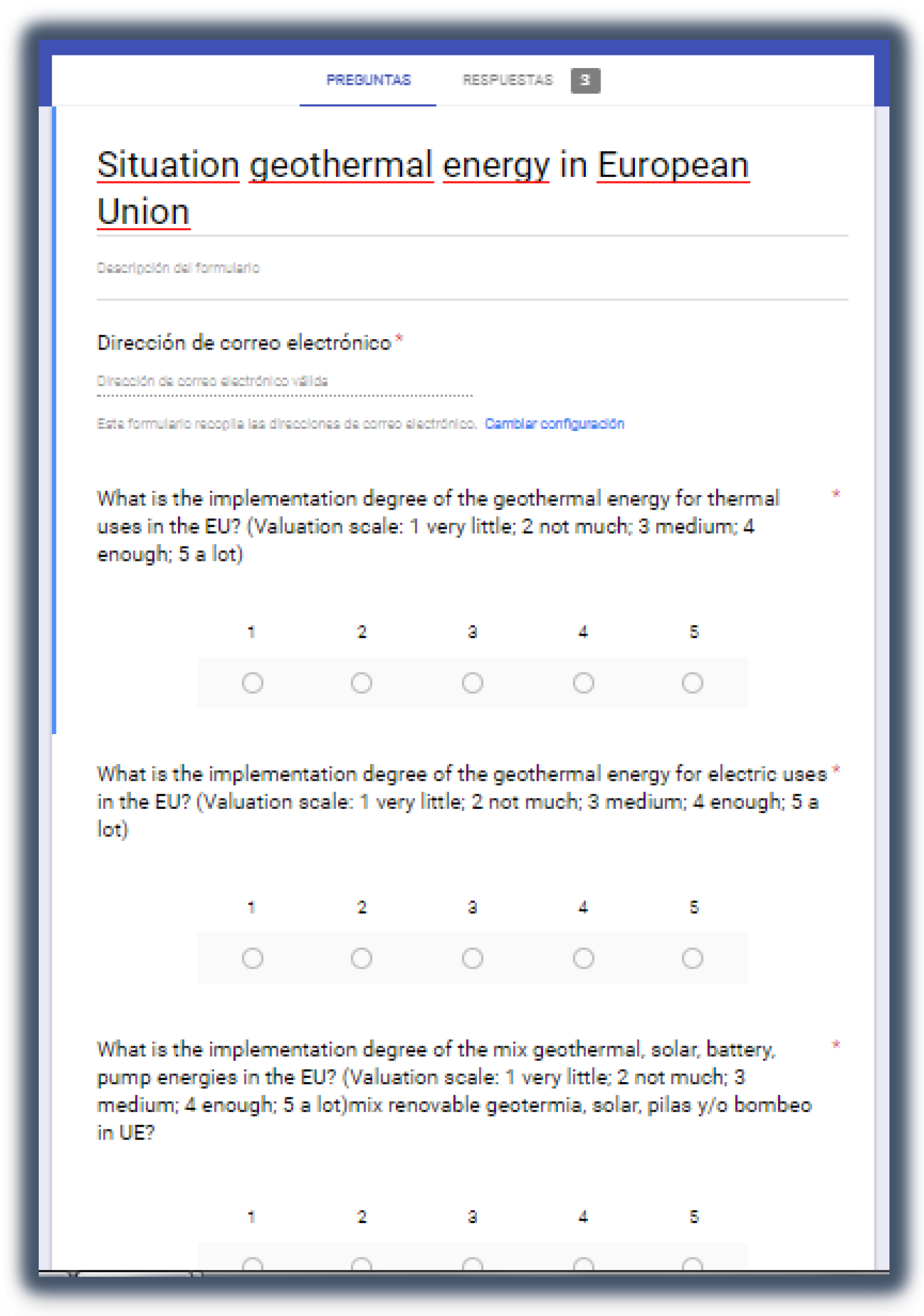
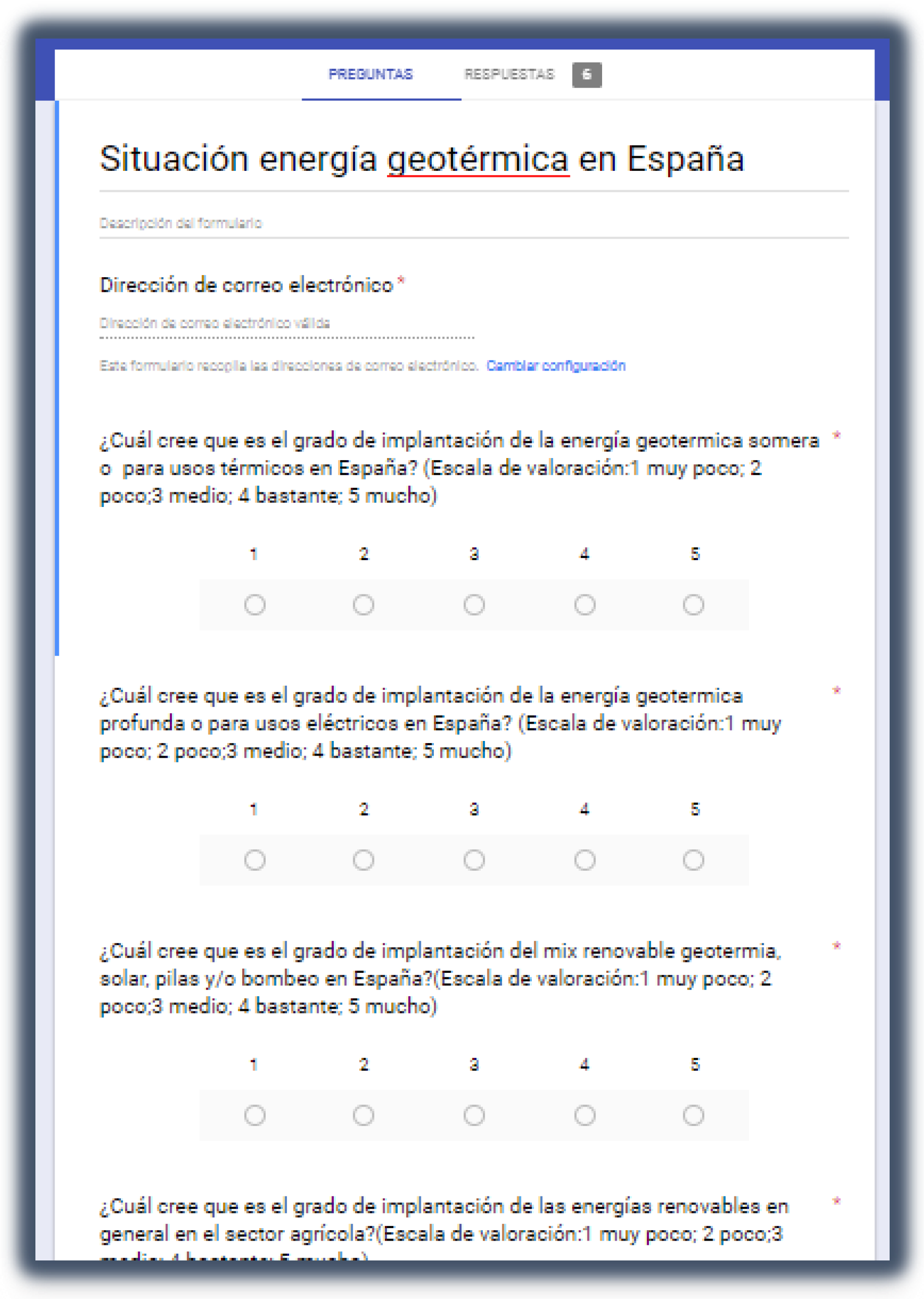
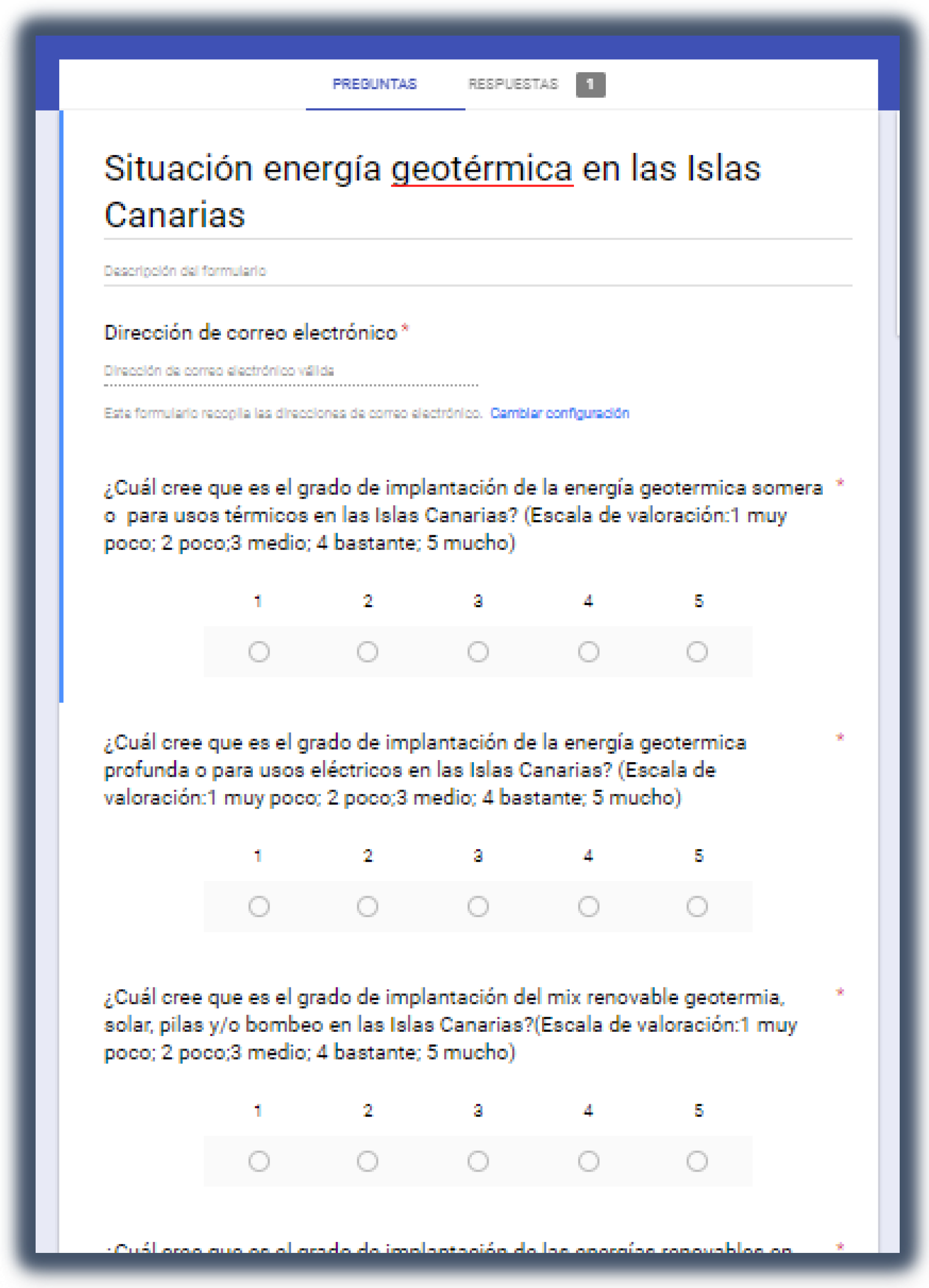
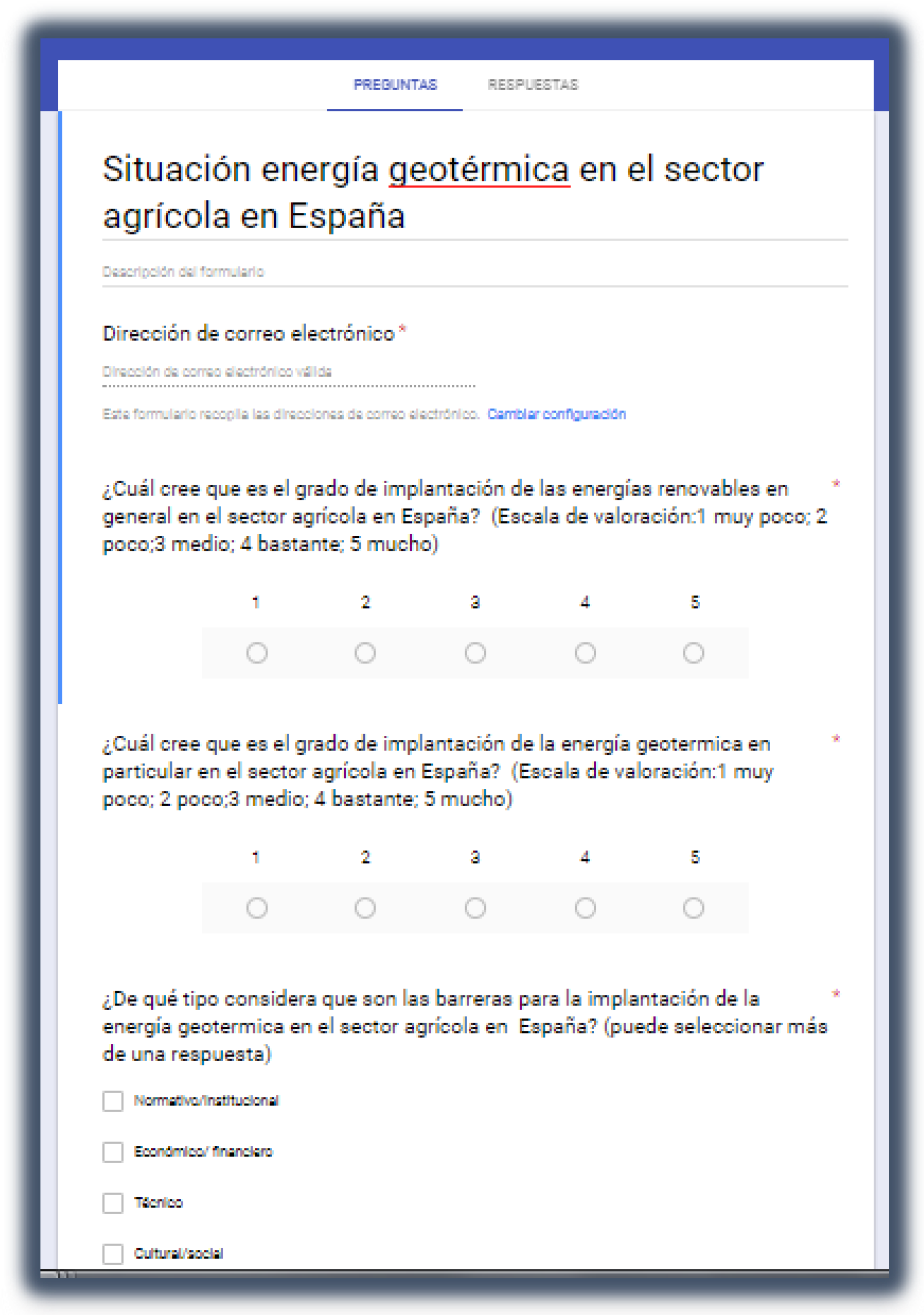
Appendix B

| BLOCK | SCENARIO | 1 | 2 | 3 | 4 | |
|---|---|---|---|---|---|---|
| QUESTIONS | SCORING SCALE | SPAIN | EU | CANARY ISLANDS | AGRICULTURAL SECTOR | |
| 1 | What do you think is the implementation level for the low-enthalpy geothermal energy? | 1: very little 2: little 3: medium 4: enough 5: a lot | Figure 2, Figure 3 and Figure 4 | |||
| What do you think is the implementation level for the high-enthalpy geothermal energy? | 1: very little 2: little 3: medium 4: enough 5: a lot | |||||
| What do you think is the implementation level for the mix renewable: geothermal, solar, battery and/or pumping? | 1: very little 2: little 3: medium 4: enough 5: a lot | |||||
| What do you think is the implementation level for the renewable energy in the agricultural sector? | 1: very little 2: little 3: medium 4: enough 5: a lot | |||||
| And the geothermal energy in particular in the agricultural sector? | 1: very little 2: little 3: medium 4: enough 5: a lot | |||||

| BLOCK | SCENARIO | 1 | 2 | 3 | 4 | |
|---|---|---|---|---|---|---|
| QUESTIONS | MULTI ANSWERS | SPAIN | EU | CANARY ISLANDS | AGRICULTURAL SECTOR | |
| 2 | Which among these do you think are the barriers to the implementation of low-enthalpy geothermal energy? | Economic/Financial Normative Technical Cultural/social Lack of knowledge Others; Big offers gas sector | Figure 5, Figure 6, Figure 7, Figure 8, Figure 9, Figure 10 and Figure 11 | |||
| Which among these do you think are the barriers to the implementation of high-enthalpy geothermal energy? | Economic/Financial Normative Technical Cultural/social Lack of knowledge Others; Big offers gas sector | |||||

| BLOCK | SCENARIO | 1 | 2 | 3 | 4 | |
|---|---|---|---|---|---|---|
| QUESTIONS | MULTI ANSWERS | SPAIN | EU | CANARY ISLANDS | AGRICULTURAL SECTOR | |
| 3 | What would be the most appropriate measures for the elimination of low-enthalpy geothermal energy barriers? | Normative change Public investment Private investment Promotion Training | Figure 12, Figure 13, Figure 14, Figure 15, Figure 16, Figure 17, Figure 18, Figure 19, Figure 20 and Figure 21 | |||
| What would be the most appropriate measures for the elimination of high-enthalpy geothermal energy barriers? | Normative change Public investment Private investment Promotion Training | |||||
| What would be the most appropriate measures for the elimination of renewable energy mix barriers? | Normative change Public investment Private investment Promotion Training | |||||
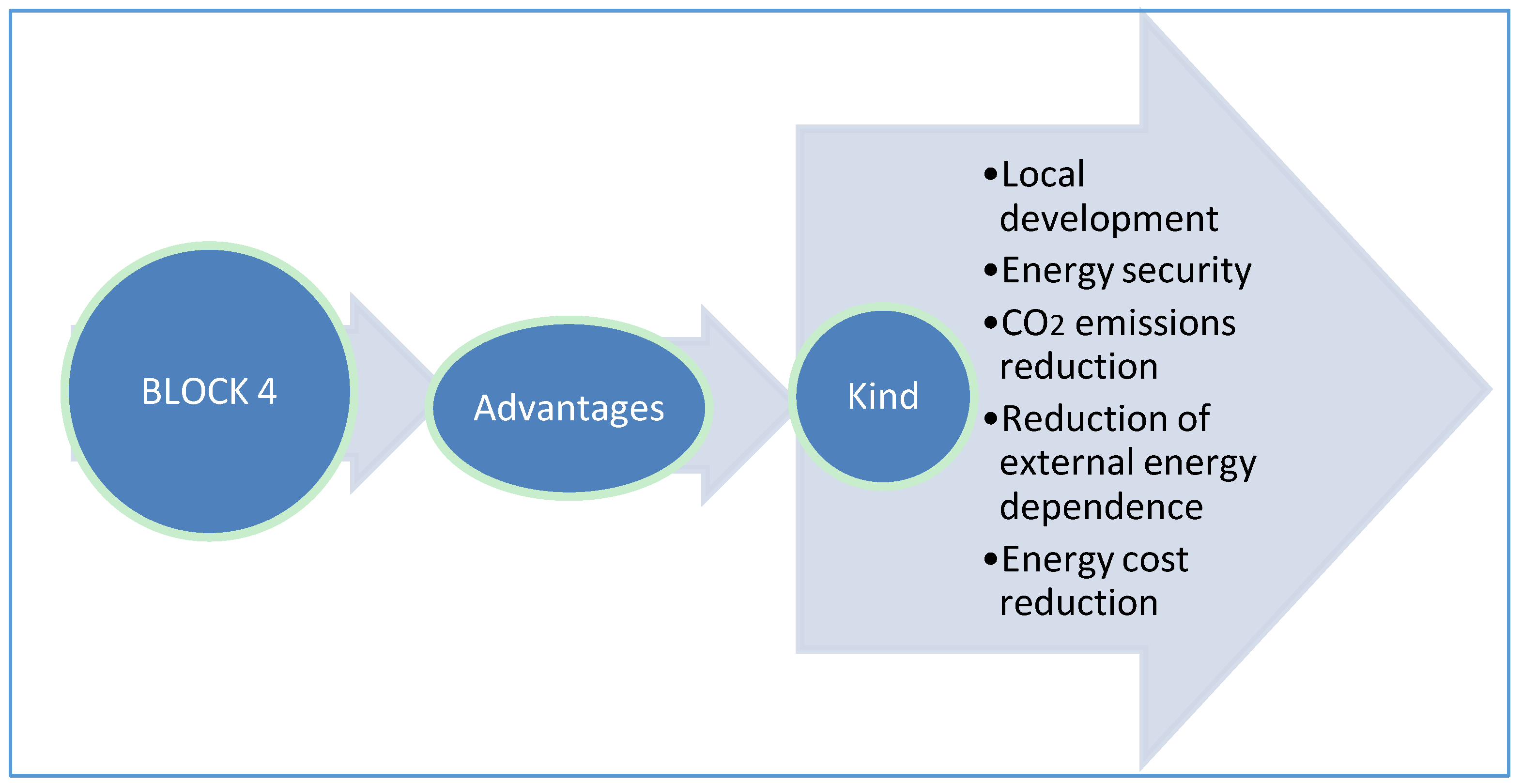
| BLOCK | SCENARIOS | 1 | 2 | 3 | 4 | |
|---|---|---|---|---|---|---|
| QUESTIONS | MULTI ANSWERS | SPAIN | EU | CANARY ISLANDS | AGRICULTURAL SECTOR | |
| 4 | What advantages would a greater development of low-enthalpy geothermal energy have? | Local development Energy security CO2 emissions reduction Reduction of external energy dependence Energy cost reduction | Figure A9, Figure A10 and Figure A11 | |||
| What advantages would a greater development of high-enthalpy geothermal energy have? | Local development. Energy security CO2 emissions reduction Reduction of external energy dependence Energy cost reduction | |||||
| What advantages would a greater development of renewable mix energy have? | Local development Energy security CO2 emissions reduction Reduction of external energy dependence Energy cost reduction | |||||
Appendix C
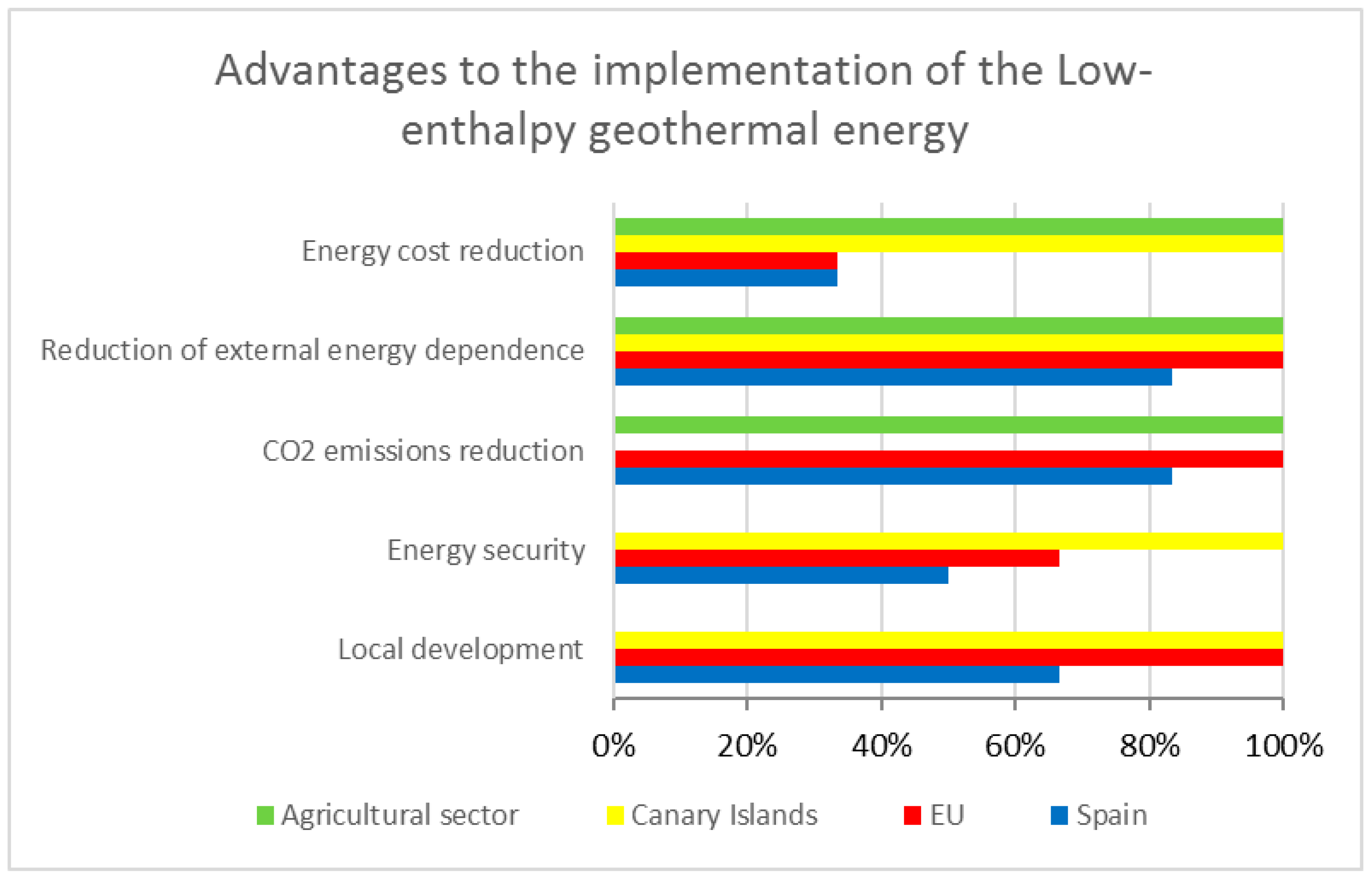
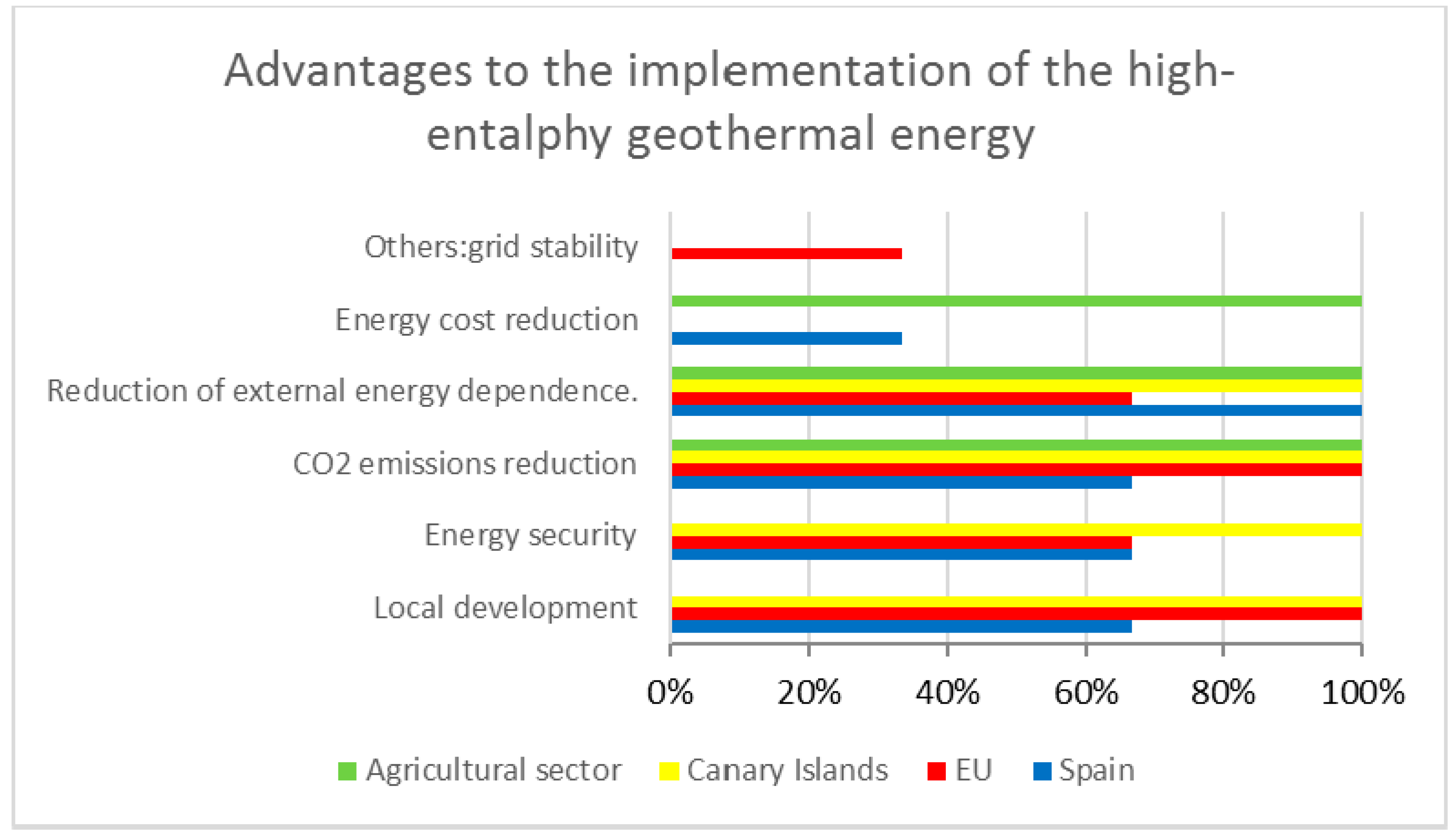
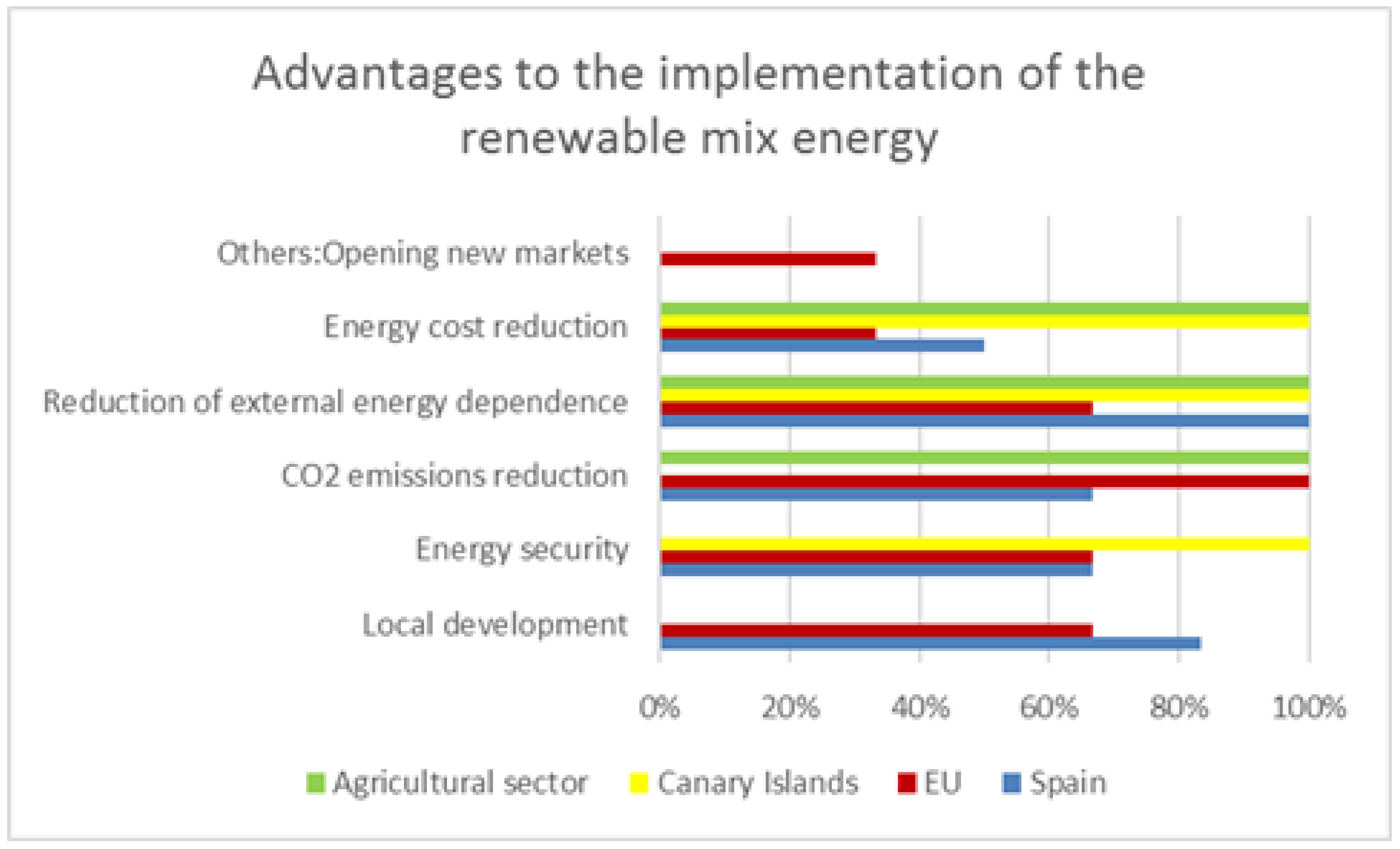
Appendix D
| SCENARIOS | 1 | 2 | 3 | 4 | |
|---|---|---|---|---|---|
| QUESTIONS | ANSWERS | SPAIN | EU | CANARY ISLANDS | AGRICULTURAL SECTOR |
| Do you think that further development of this technology (low- and/or high-enthalpy geothermal energy and/or energy mix with other sources of energy) would reduce its cost? | Yes No DK/DA | Figure A12, Figure A13, Figure A14, Figure A15, Figure A16, Figure A17, Figure A18 and Figure A19 | |||
| Do you think that the final consumer is becoming more demanding with the origin of the energy he (she) consumes? | Yes No DK/DA | ||||
| Do you believe that the final consumer is aware of the environmental, social and economic benefits of clean energy consumption? | Yes No DK/DA | ||||
| Do you think that the initial investment is greater due to the use of a new technology? | Yes No DK/DA | ||||
| Do you think that geothermal energy is at a cost disadvantage with other renewable energies of greater implantation? | Yes No DK/DA | ||||
| Do you think that the current government situation is an obstacle on the implementation of this technology? | Yes No DK/DA | ||||
| Do you think that companies are increasingly aware of environmental issues beyond purely economic ones? | Yes No DK/DA | ||||
| Do you think that the institutions continue to support fossil fuels and the creation of cross-border energy networks to the detriment of local renewable energies? | Yes No DK/DA | ||||
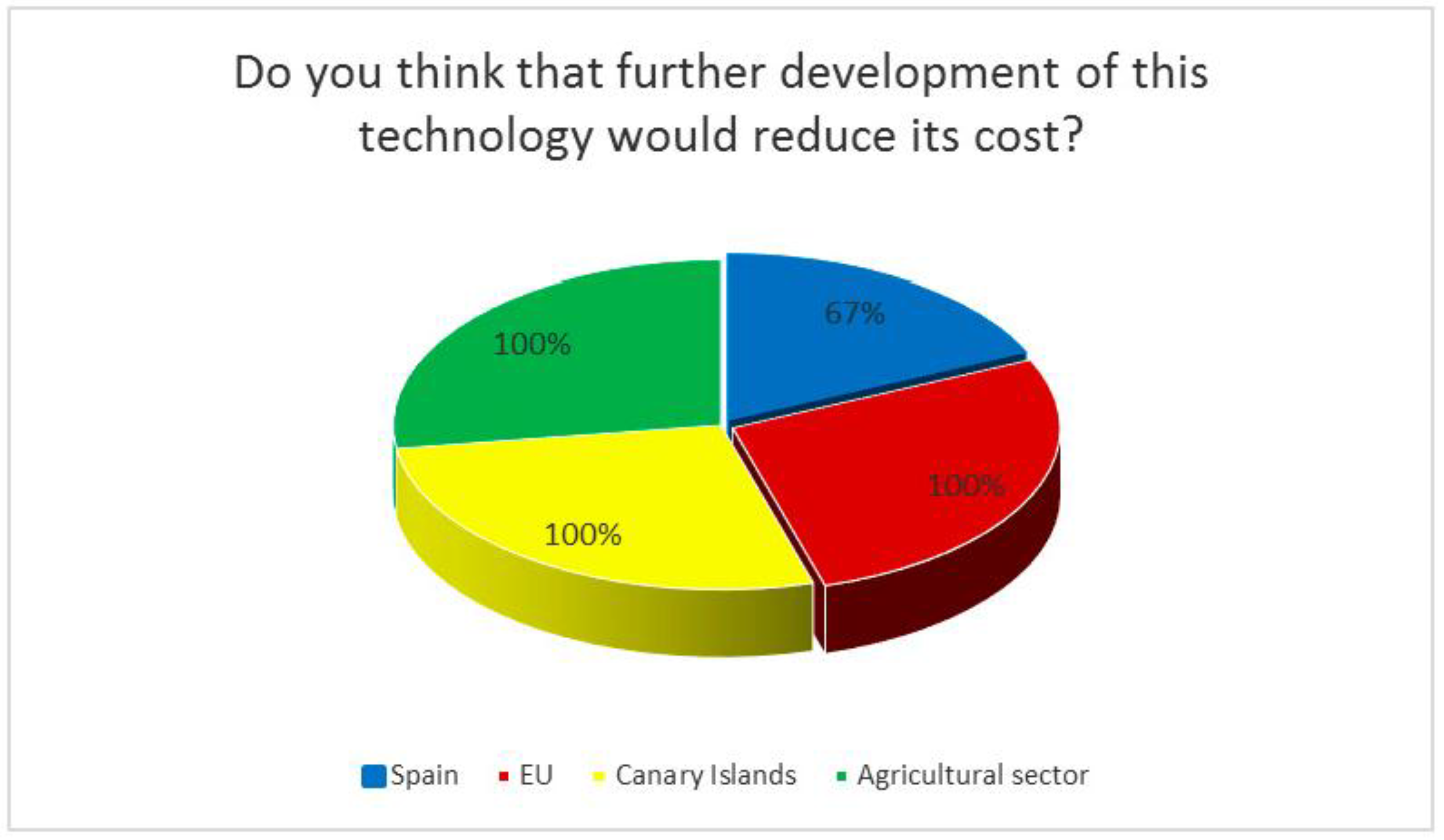
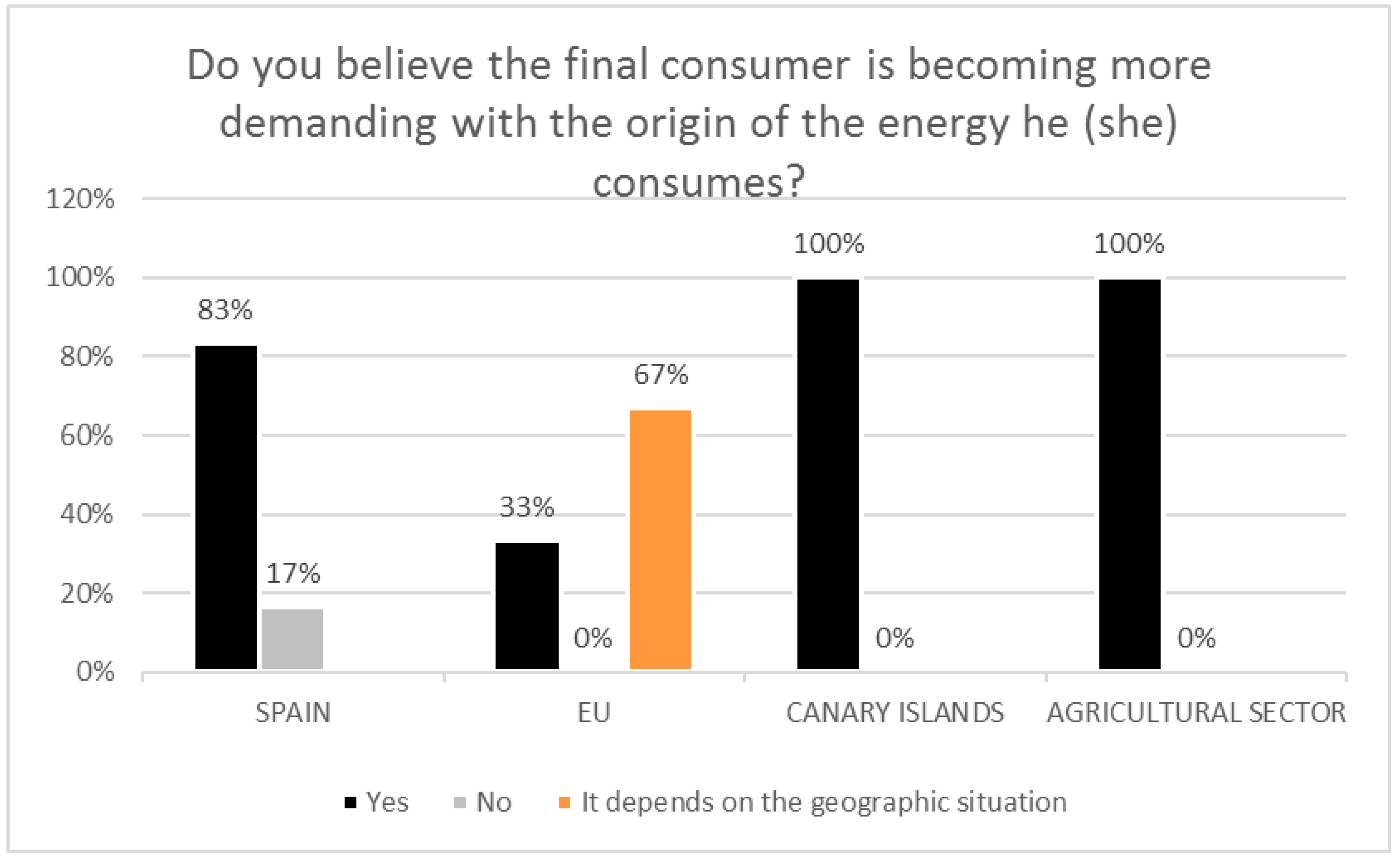
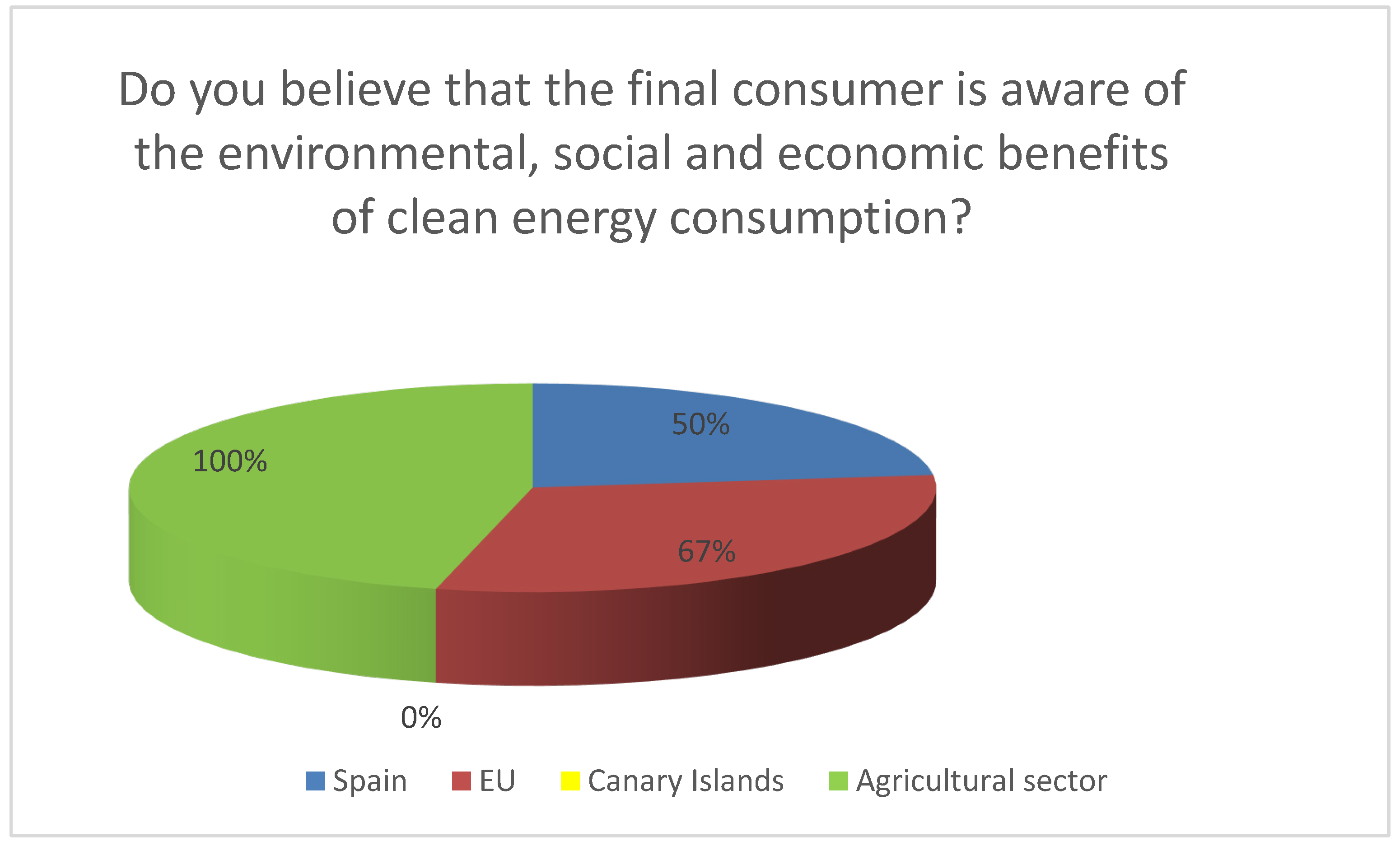
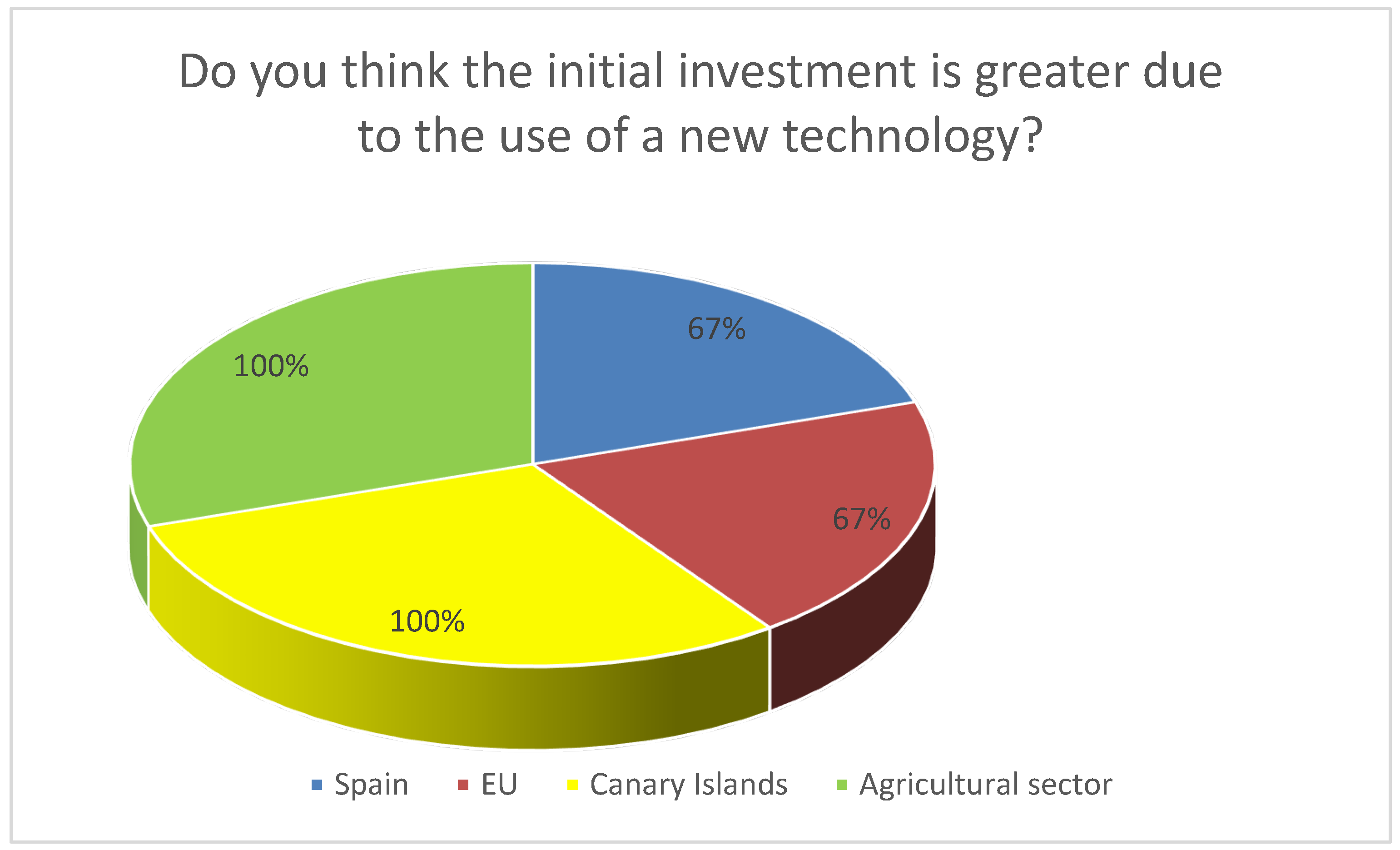
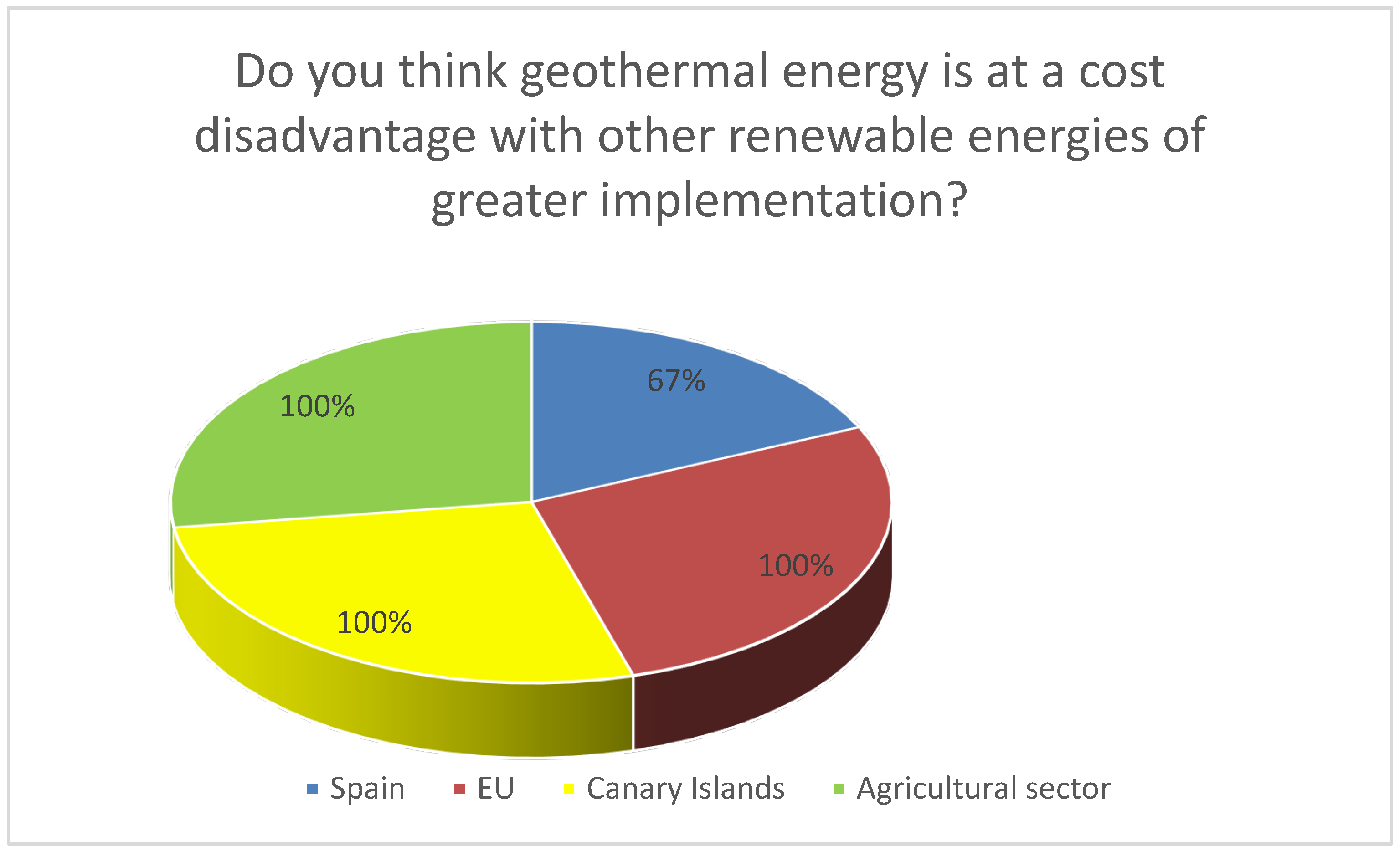
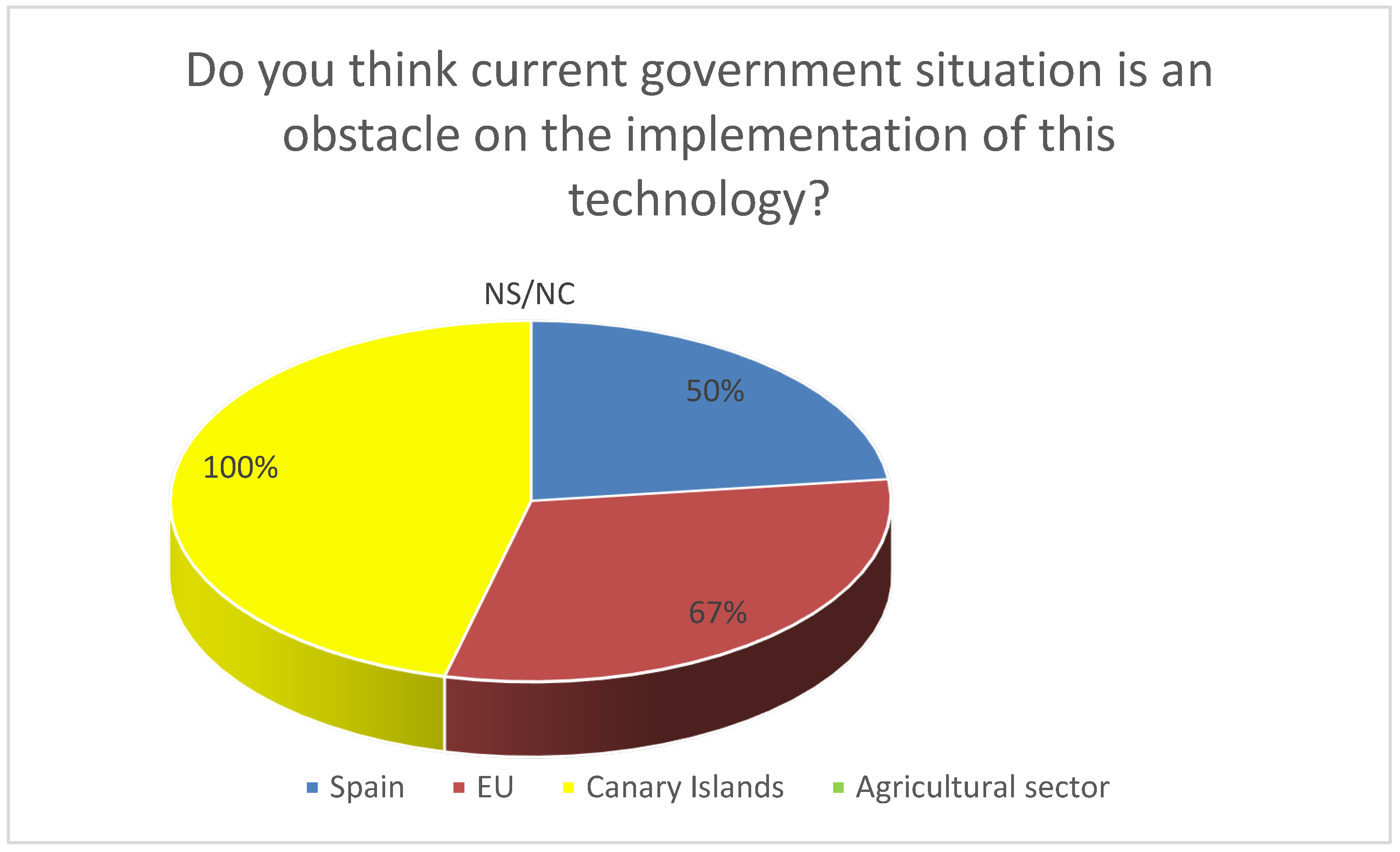
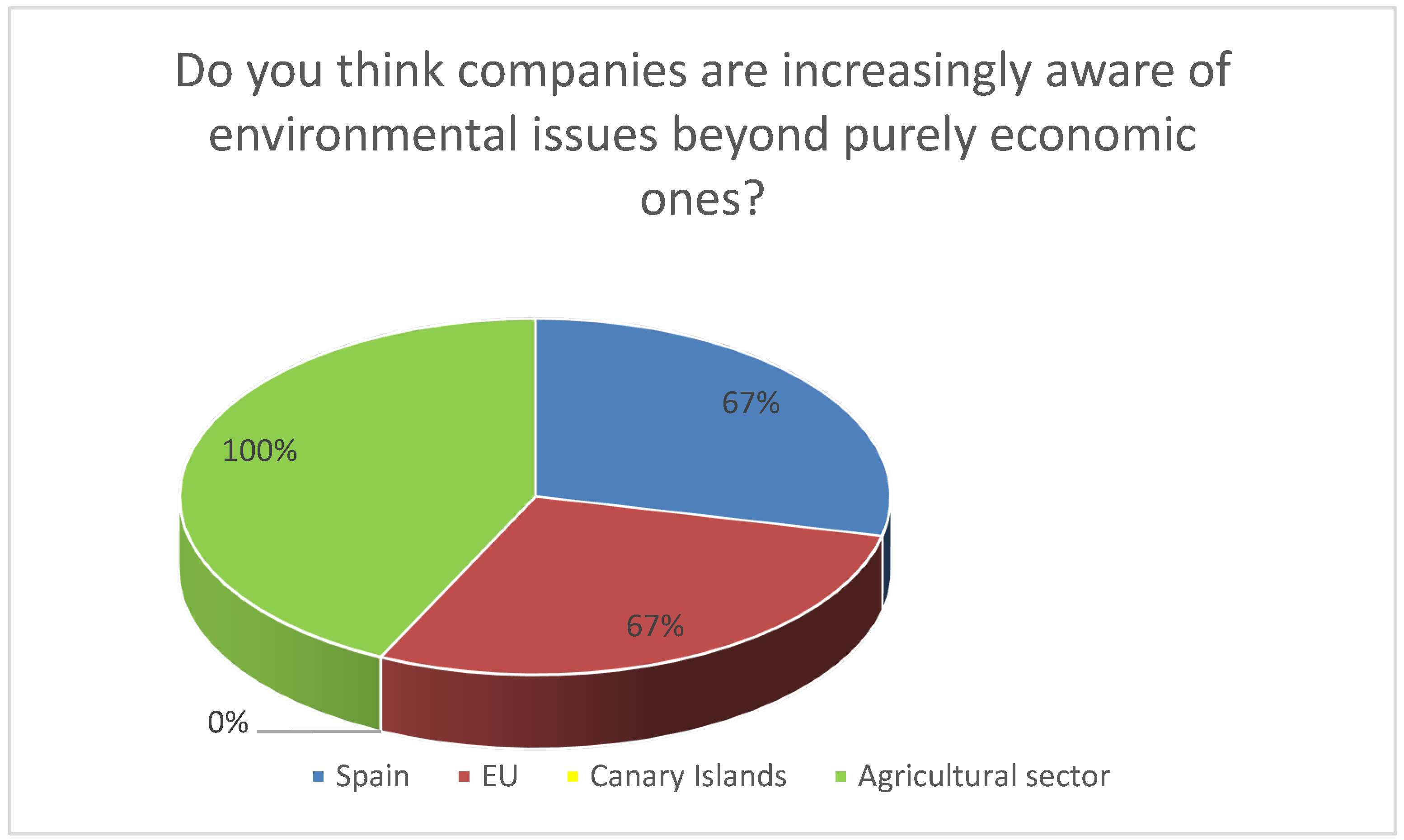
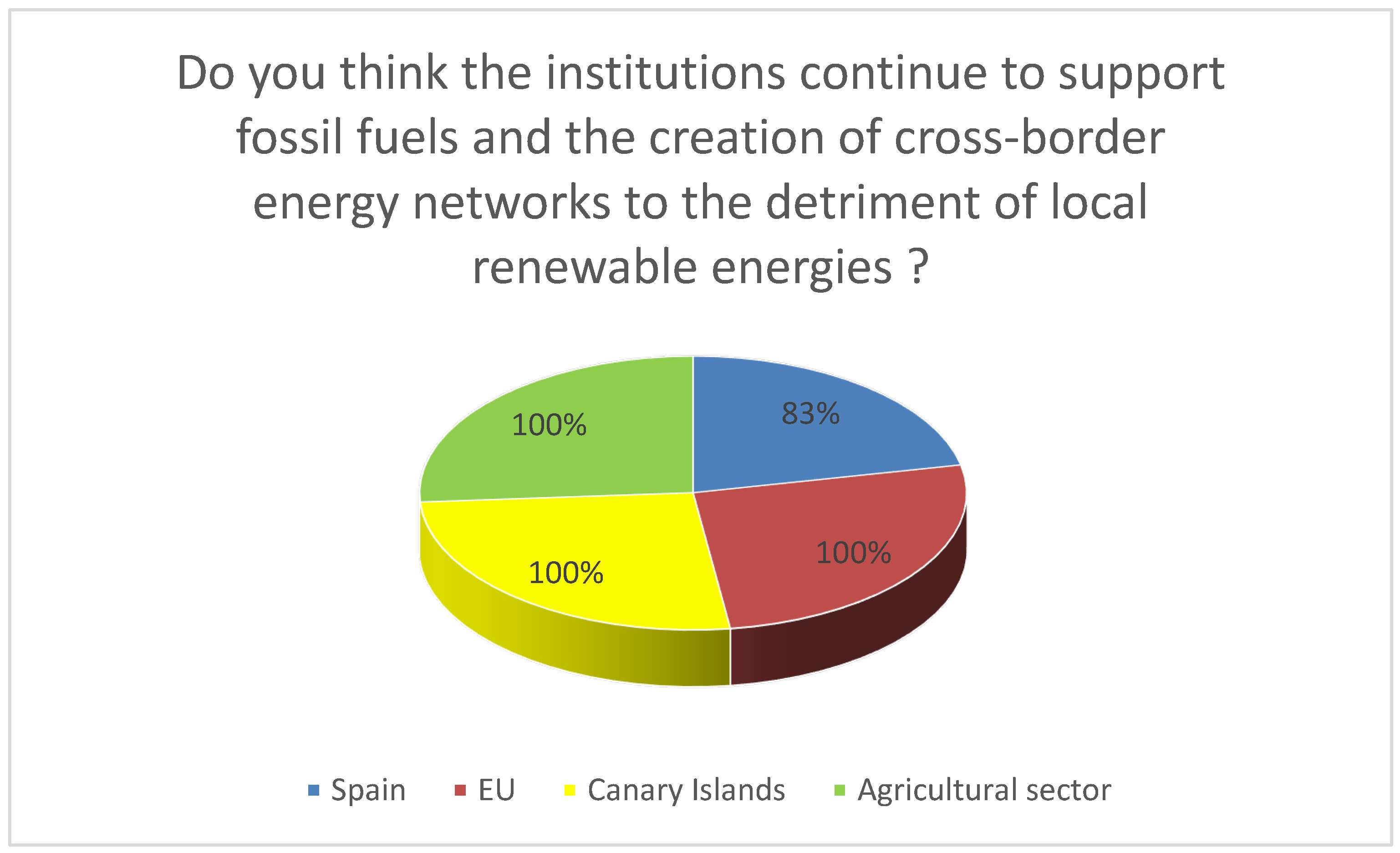
References
- Lucas, H.; Fifita, S.; Talab, I.; Marschel, C.; Cabeza, L. Critical challenges and capacity building needs for renewable energy deployment in Pacific Small Island Developing States (Pacific SIDS). Renew. Energy 2017, 107, 42–52. [Google Scholar] [CrossRef]
- Sanyé-Mengual, E.; Romanos, H.; Molina, C.; Oliver, M.A.; Ruiz, N.; Pérez, M. Environmental and self-sufficiency assessment of the energy metabolism of tourist hubs on Mediterranean Islands: The case of Menorca (Spain). Energy Policy 2014, 65, 377–387. [Google Scholar] [CrossRef] [Green Version]
- Declaración de Madrid. Cumbre Para las Interconexiones Energéticas España-Francia-Portugal-Unión Europea; Declaración de Madrid: Madrid, Spain, 2015. [Google Scholar]
- Energías Renovables. Más Interconexiones Sin Más Renovables No Harán Más Competitiva a la Industria Europea. Available online: https://www.energias-renovables.com/panorama/más-interconexiones-sin-mas-renovables-no-haran-20150311 (accessed on 31 August 2017).
- Ramón Ducoy, F.J. Implantación de Energías Renovables En una Planta de Producción de Amoniaco; Universidad de Sevilla: Proyecto fin de carrera, Spain, 2012. [Google Scholar]
- Compromiso Empresarial. Geotermia: Energía Desde el Corazón de la Tierra. Available online: http://www.compromisoempresarial.com/rsc/2014/04/geotermia-energia-desde-el-corazon-de-la-tierra (accessed on 31 August 2017).
- Economou, A. Renewable energy resources and sustainable development in Mykonos (Greece). Renew. Sustain. Energy Rev. 2010, 14, 1496–1501. [Google Scholar] [CrossRef]
- Karagiannis, I.C.; Soldatos, P.G. Estimation of critical CO2 values when planning the power source in water desalination: The case of the small Aegean islands. Energy Policy 2010, 38, 3891–3897. [Google Scholar] [CrossRef]
- Giatrakos, G.; Tsoutsos, T.D.; Zografakis, N. Sustainable power planning for the island of Crete. Energy Policy 2009, 37, 1222–1238. [Google Scholar] [CrossRef]
- Michalena, E.; Hills, J. Renewable energy issues and implementation of European energy policy: The missing generation? Energy Policy 2012, 45, 201–216. [Google Scholar] [CrossRef]
- Nguyen, M.V.; Arason, S.; Gissurarson, M.; Pálsson, P.G. Uses of Geothermal Energy in Food and Agriculture: Opportunities for Developed Countries; Food and Agriculture Organization of the United Nations (FAO): Rome, Italy, 2015. [Google Scholar]
- Instituto Geológico y Minero (IGME). Casos Prácticos Geotermia. Available online: http://www.igme.es/Geotermia/Ficheros%20PDF/Contenido.pdf (accessed on 24 April 2017).
- Sibbitt, B.; McClenahan, D.; Djebbar, R.; Thornton, J.; Wong, B.; Carriere, J. The performance of a high solar fraction seasonal storage district heating system—Five years of operation. Energy Procedia 2012, 30, 856–865. [Google Scholar] [CrossRef]
- Comisión Europea. Multiplaying Sustainable Energy Communities—A Blue Print for Actions. Available online: http://ec.europa.eu/energy/intelligent/projects/en/partners/stadtwerke-crailsheim-gmbh (accessed on 24 August 2017).
- Wesselink, M.; Liu, W.; Koornneef, J.; Van den Broek, M. Conceptual market potential framework of high temperature aquifer thermal energy storage a case study in the Netherlands. Energy 2018, 147, 477–489. [Google Scholar] [CrossRef]
- Romero-Rubio, C.; de Andrés Díaz, J.R. Sustainable energy communities: A study contrasting Spain and Germany. Energy Policy 2015, 85, 397–409. [Google Scholar] [CrossRef]
- Büyüközkan, G.; Güleryüz, S. Evaluation of Renewable Energy Resources in Turkey using an integrated MCDM approach with linguistic interval fuzzy preference Relations. Energy 2017, 123, 149–163. [Google Scholar] [CrossRef]
- Boie, I.; Fernandes, C.; Frías, P.; Klobasa, M. Efficient strategies for the integration of renewable energy into future energy infrastructures in Europe—An analysis based on transnational modeling and case studies for nine European regions. Energy Policy 2014, 67, 170–185. [Google Scholar] [CrossRef]
- Borge-Diez, D.; Colmenar-Santos, A.; Pérez-Molina, C.; López-Rey, A. Geothermal source heat pumps under energy services companies finance scheme to increase energy efficiency and production in stockbreeding facilities. Energy 2015, 88, 821–836. [Google Scholar] [CrossRef]
- Ozgener, O. Use of solar assisted geothermal heat pump and small wind turbine systems for heating agricultural and residential buildings. Energy 2010, 35, 262–268. [Google Scholar] [CrossRef]
- Bhattacharya, M.; Churchill, S.A.; Paramati, S.R. The dynamic impact of renewable energy and institutions on economic output and CO2 emissions across regions. Renew. Energy 2017, 111, 157–167. [Google Scholar] [CrossRef]
- Dael, M.V.; Lizin, S.; Swinnen, G.; Van Passel, V. Young people’s acceptance of bioenergy and the influence of attitude strength on information provision. Renew. Energy 2017, 107, 417–430. [Google Scholar] [CrossRef]
- Cagno, E.; Trianni, A.; Worrel, E.; Miggiano, F. Barriers and drivers for energy efficiency: Different perspectives from an exploratory study in the Netherlands. Energy Procedia 2014, 61, 1256–1260. [Google Scholar] [CrossRef]
- Lin, B.; Omoju, O.E. Focusing on the right targets. Economic factors driving non-hydro renewable energy transition. Renew. Energy 2017, 113, 52–63. [Google Scholar] [CrossRef]
- Martín Romero, C. Metodología de investigación en estudios de usuarios. Revista General de Información y Documentación 2007, 17, 129–149. [Google Scholar]
- Sustersic, V.M.; Babic, M.J.; Gordic, D.S.; Despotovic, M.; Milovanovic, D.M. An overview of the regulatory framework for the geothermal energy in Europe and Serbia. Therm. Sci. 2010, 14, s115–s123. [Google Scholar] [CrossRef]
- Comisión Europea. Acción Por el Clima. Paquete de Medidas Sobre Clima y Energía Hasta el 2020. Available online: https://ec.europa.eu/clima/policies/strategies/2020_es (accessed on 15 February 2018).
- Sardosky, P. Renewable energy consumption and income in emerging economies. Energy Policy 2009, 37, 4021–4028. [Google Scholar]
- Marques, A.C.; Fuinhas, J.A.; Manso, J.R.P. Motivations driving renewable energy in European countries: A panel data approach. Energy Policy 2010, 38, 6877–6885. [Google Scholar] [CrossRef]
- Asociación de Empresas de Energías Renovables. Estudio del Impacto Macroeconómico de las Energías Renovables en España 2015; Asociación de Productores de Energías Renovables (APPA): Madrid, Spain, 2016. [Google Scholar]
- Goosen, M.; Mahmoudi, H.; Ghaffour, N. Water Desalination Using Geothermal Energy. Energies 2010, 3, 1423–1442. [Google Scholar] [CrossRef] [Green Version]
- Blázquez, C.S.; Martín, A.F.; Nieto, I.M.; González-Aguilera, D. Economic and Environmental Analysis of Different District Heating Systems Aided by Geothermal Energy. Energies 2018, 11, 1265. [Google Scholar] [CrossRef]
- Bonamente, E.; Aquino, A. Life-Cycle Assessment of an Innovative Ground-Source Heat Pump System with Upstream Thermal Storage. Energies 2017, 10, 1854. [Google Scholar] [CrossRef]
- Calise, F.; Capuano, D.; Vanoli, L. Dynamic Simulation and Exergo-Economic Optimization of a Hybrid Solar–Geothermal Cogeneration Plant. Energies 2015, 8, 2606–2646. [Google Scholar] [CrossRef] [Green Version]
- Patsialis, T.; Kougias, J.; Kazakis, N.; Theodossiou, N.; Droege, P. Supporting Renewables’ Penetration in Remote Areas through the Transformation of Non-Powered Dams. Energies 2016, 9, 1054. [Google Scholar] [CrossRef]
- Alam, M.; Bhattacharyya, S. Decentralized Renewable Hybrid Mini-Grids for Sustainable Electrification of the Off-Grid Coastal Areas of Bangladesh. Energies 2016, 9, 268. [Google Scholar] [CrossRef] [Green Version]
- Franzitta, V.; Curto, D.; Milone, D.; Rao, D. Assessment of Renewable Sources for the Energy Consumption in Malta in the Mediterranean Sea. Energies 2016, 9, 1034. [Google Scholar] [CrossRef]
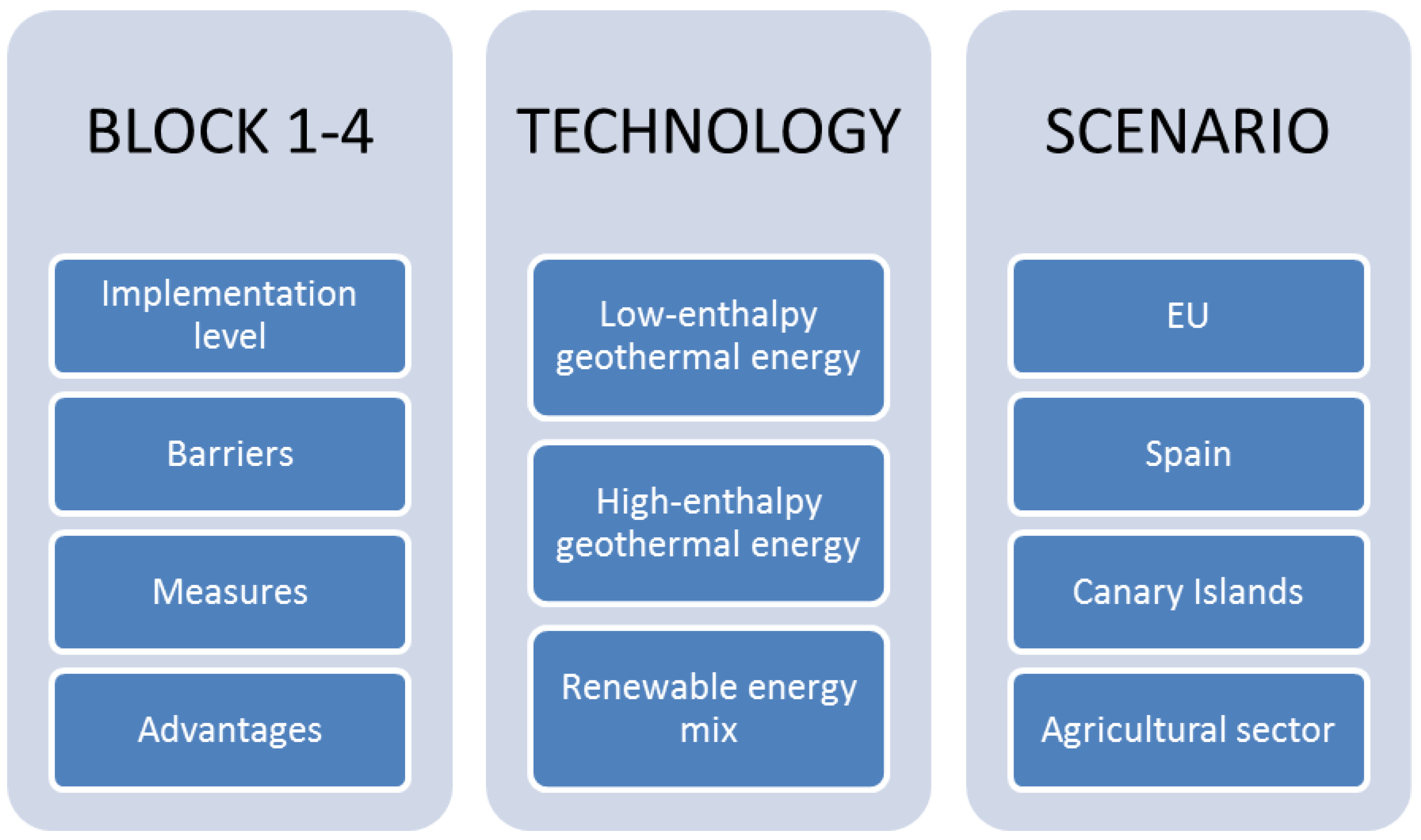
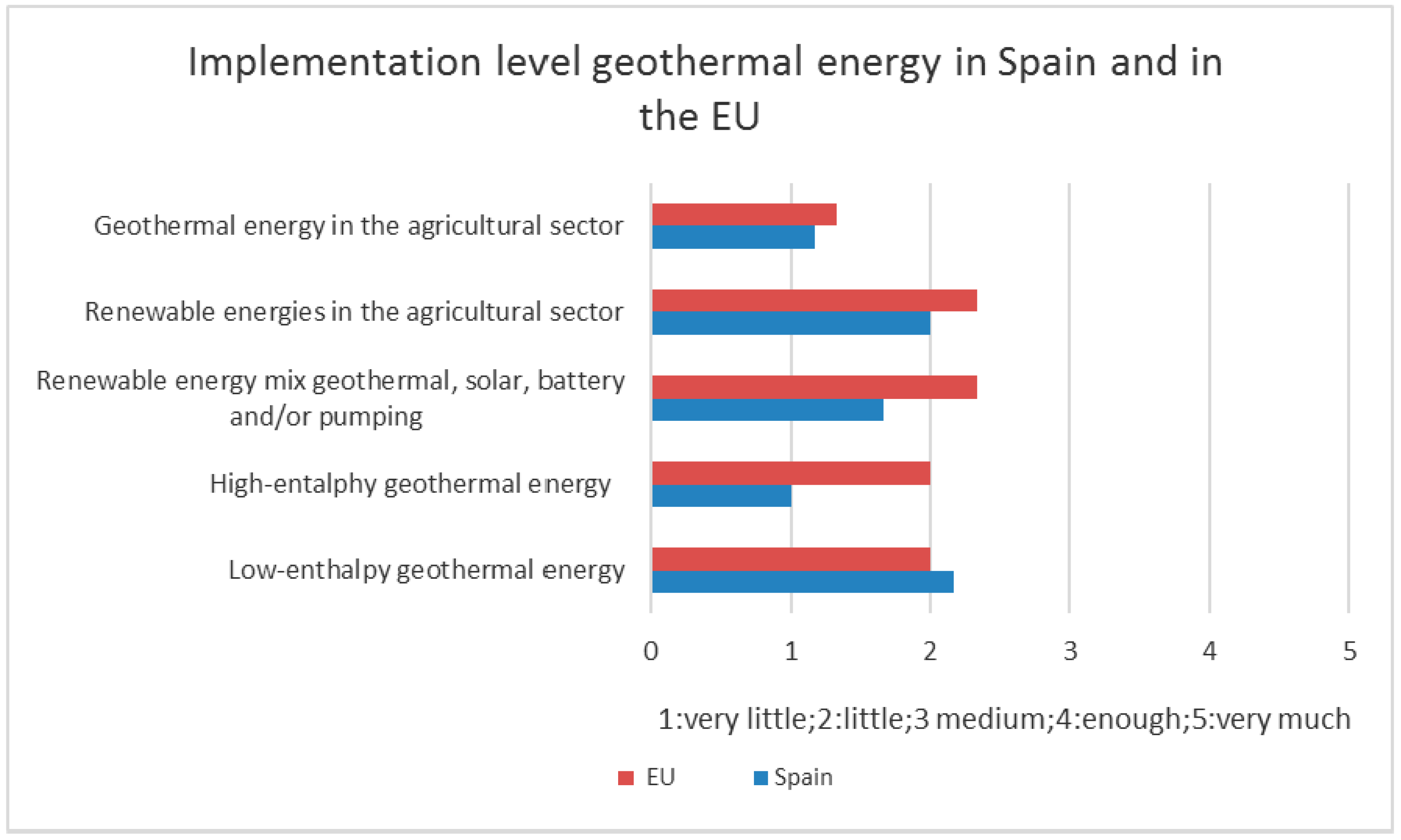
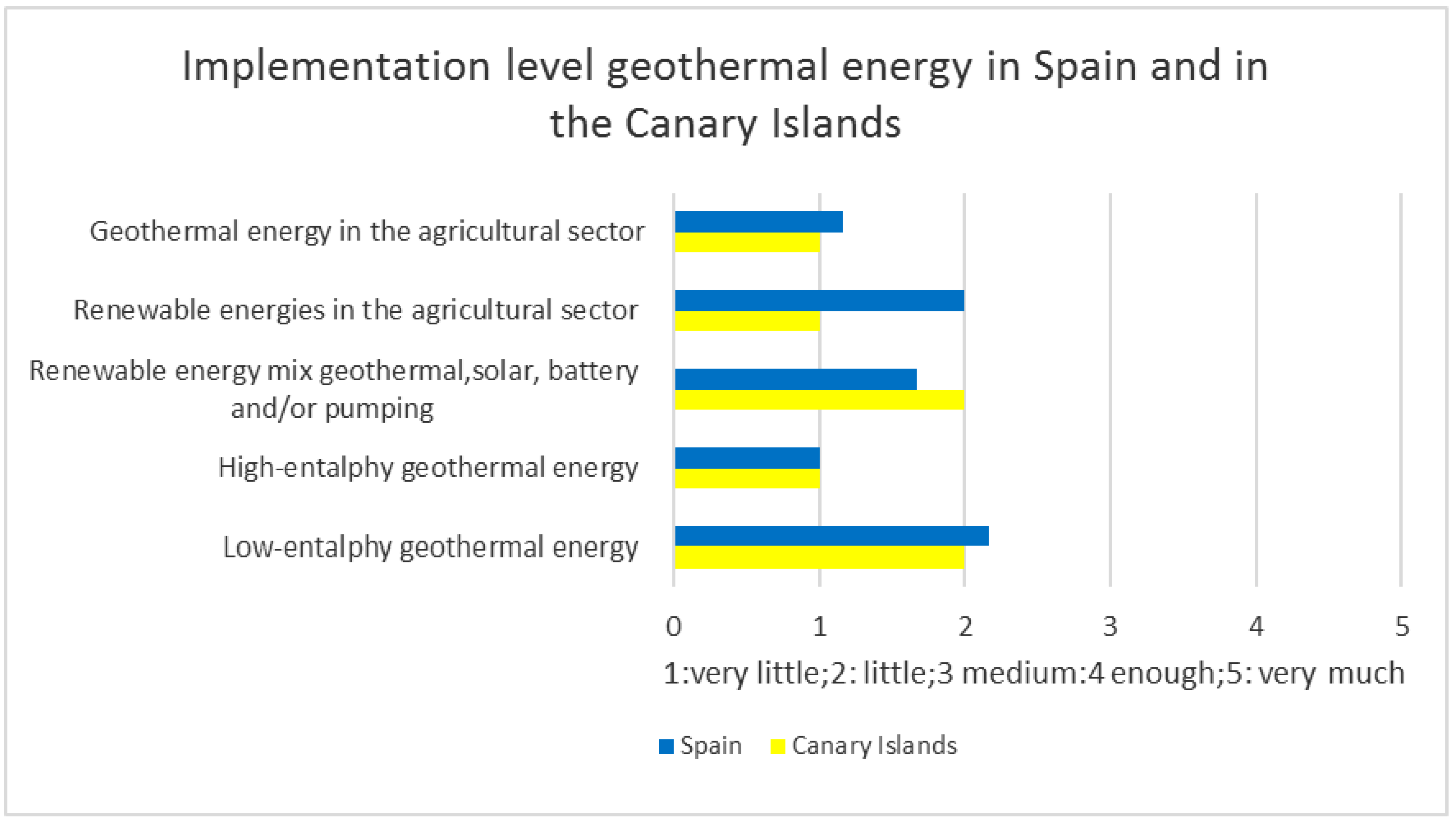
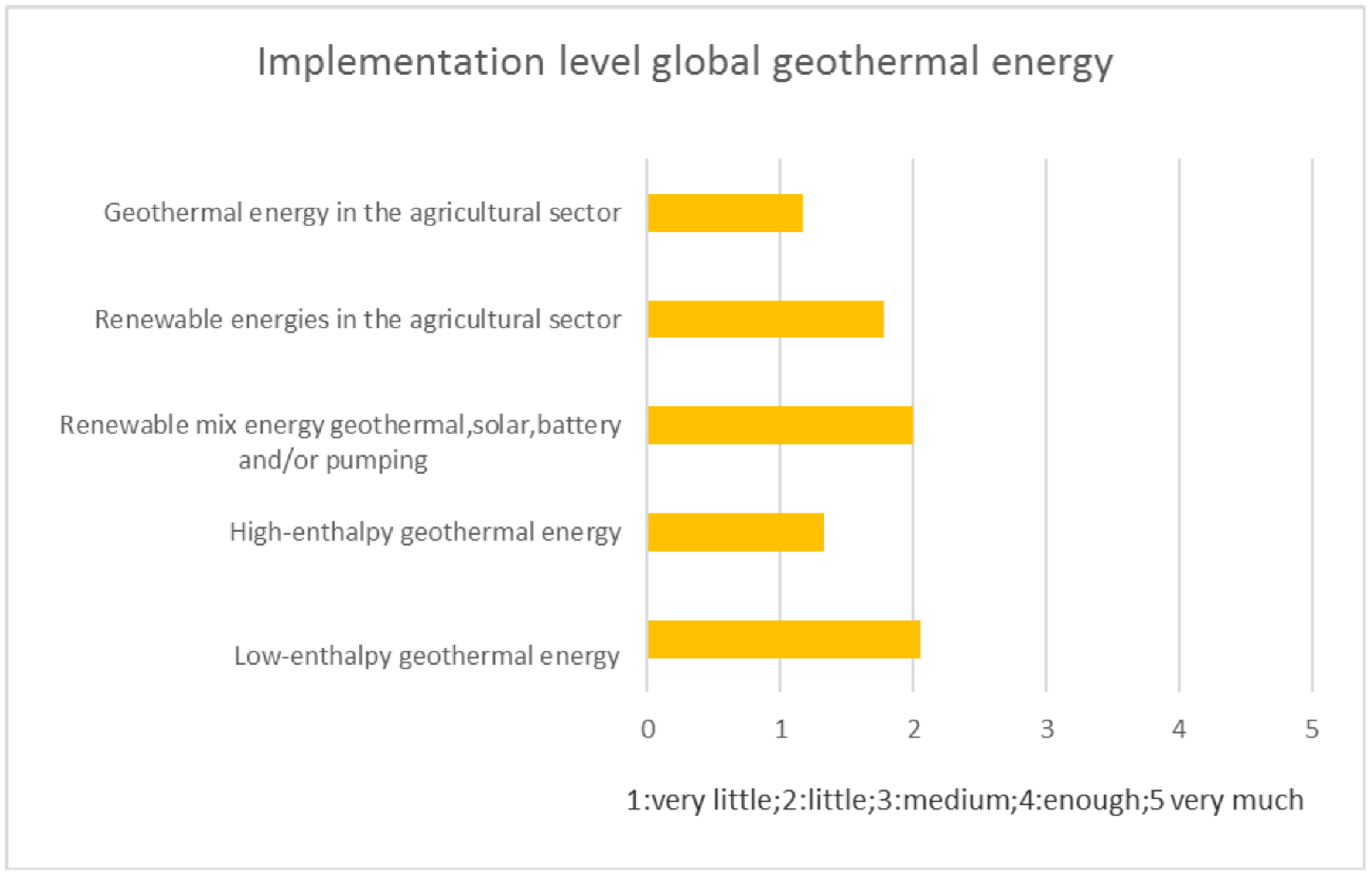
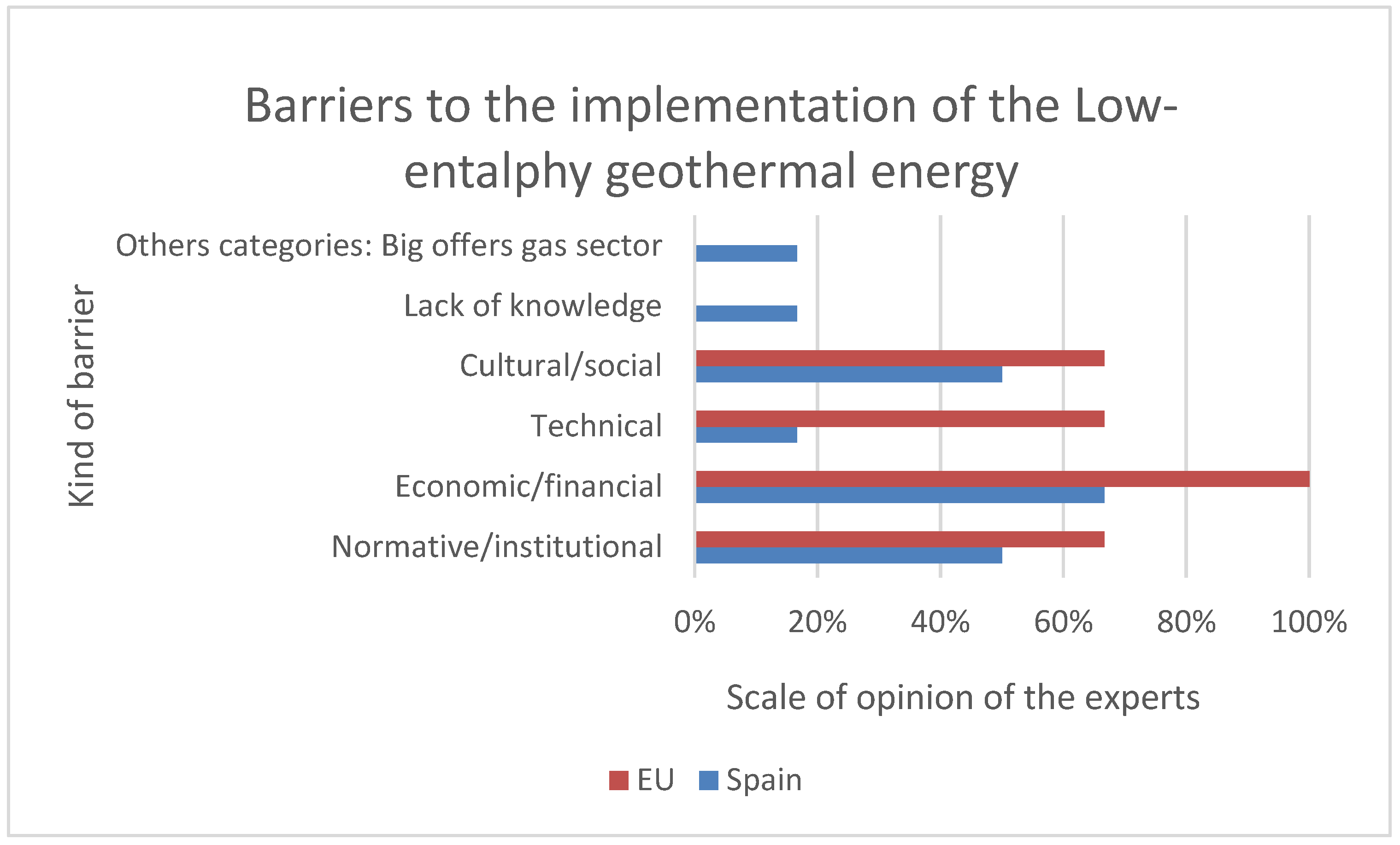
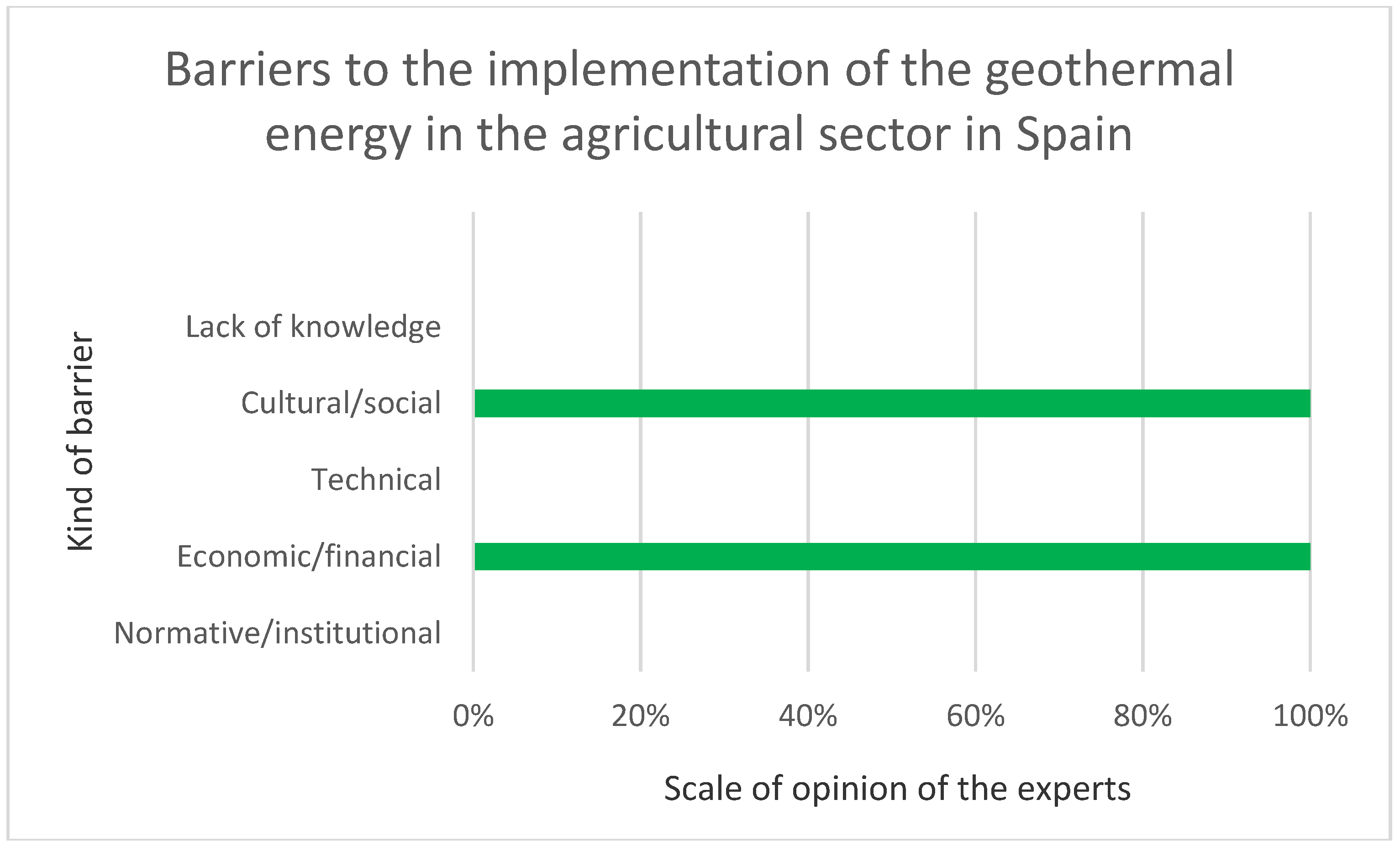
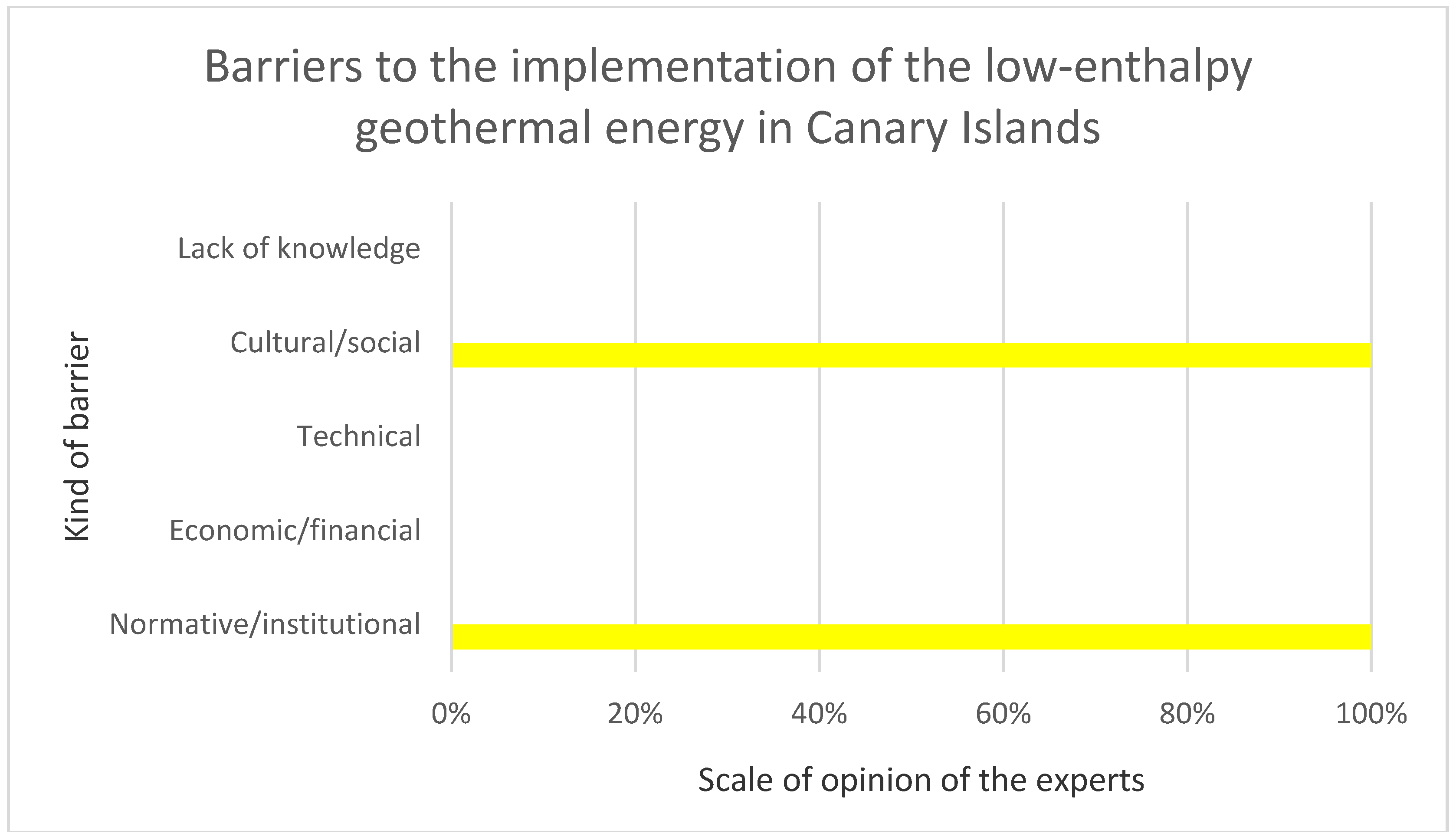
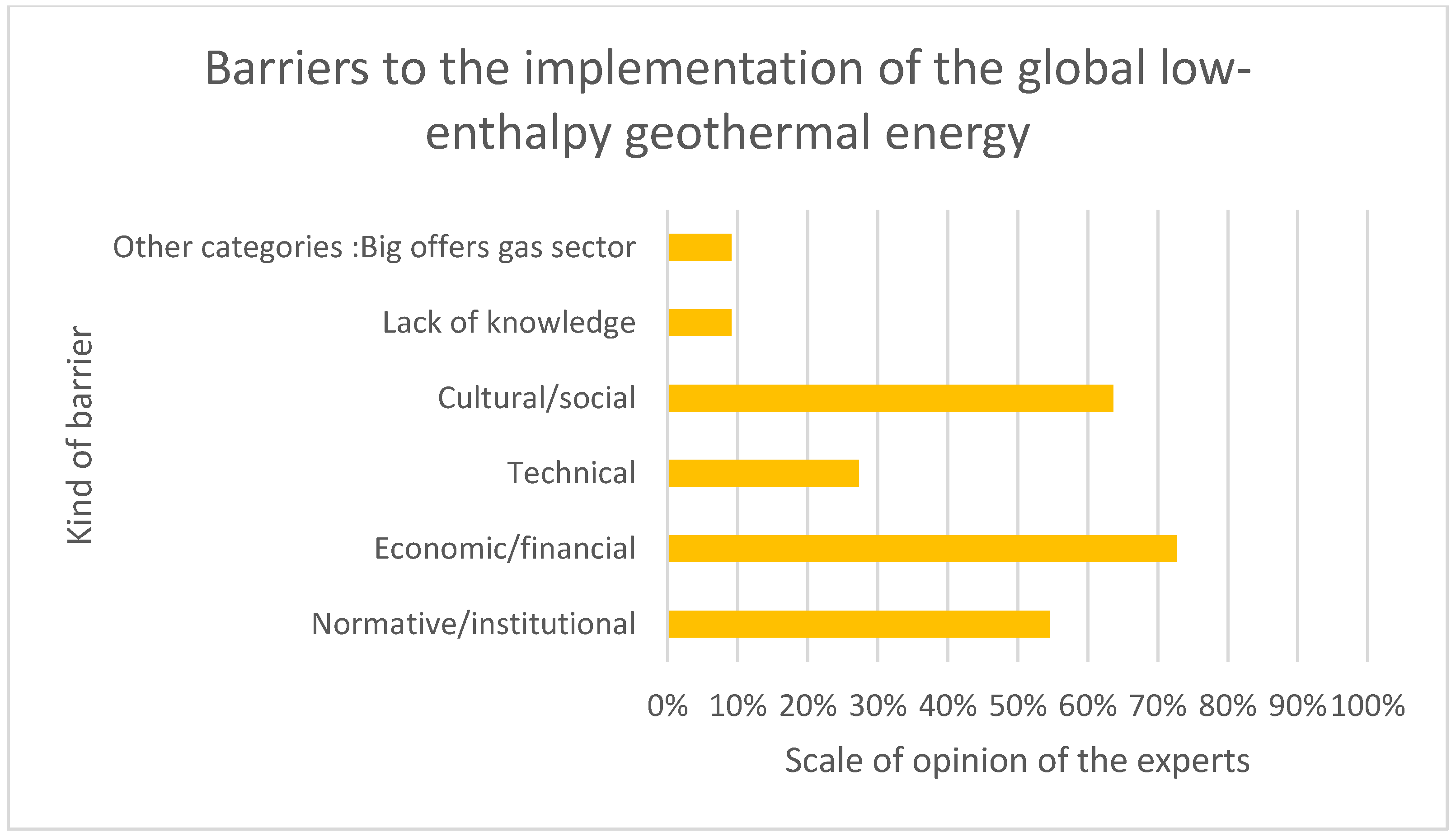
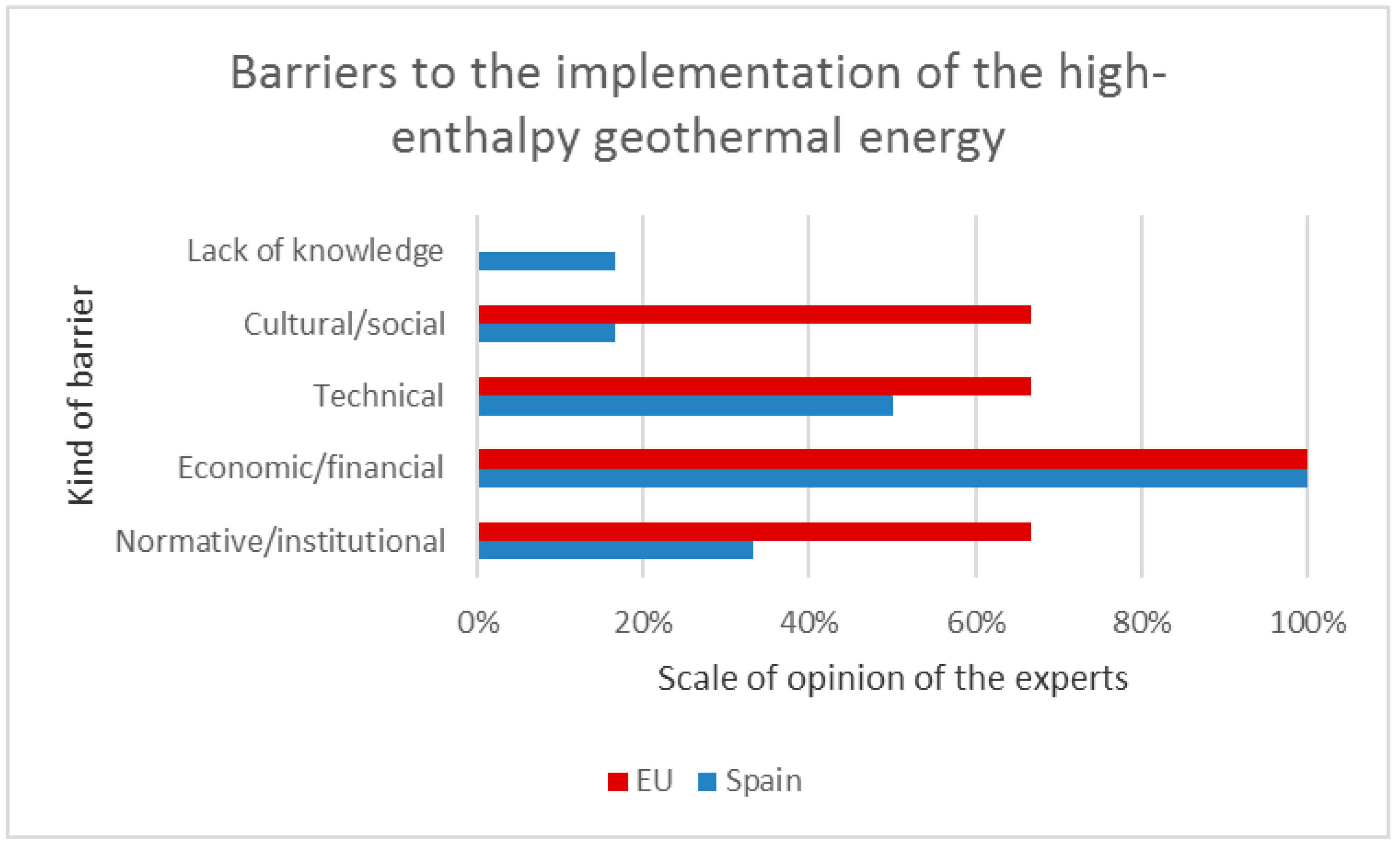
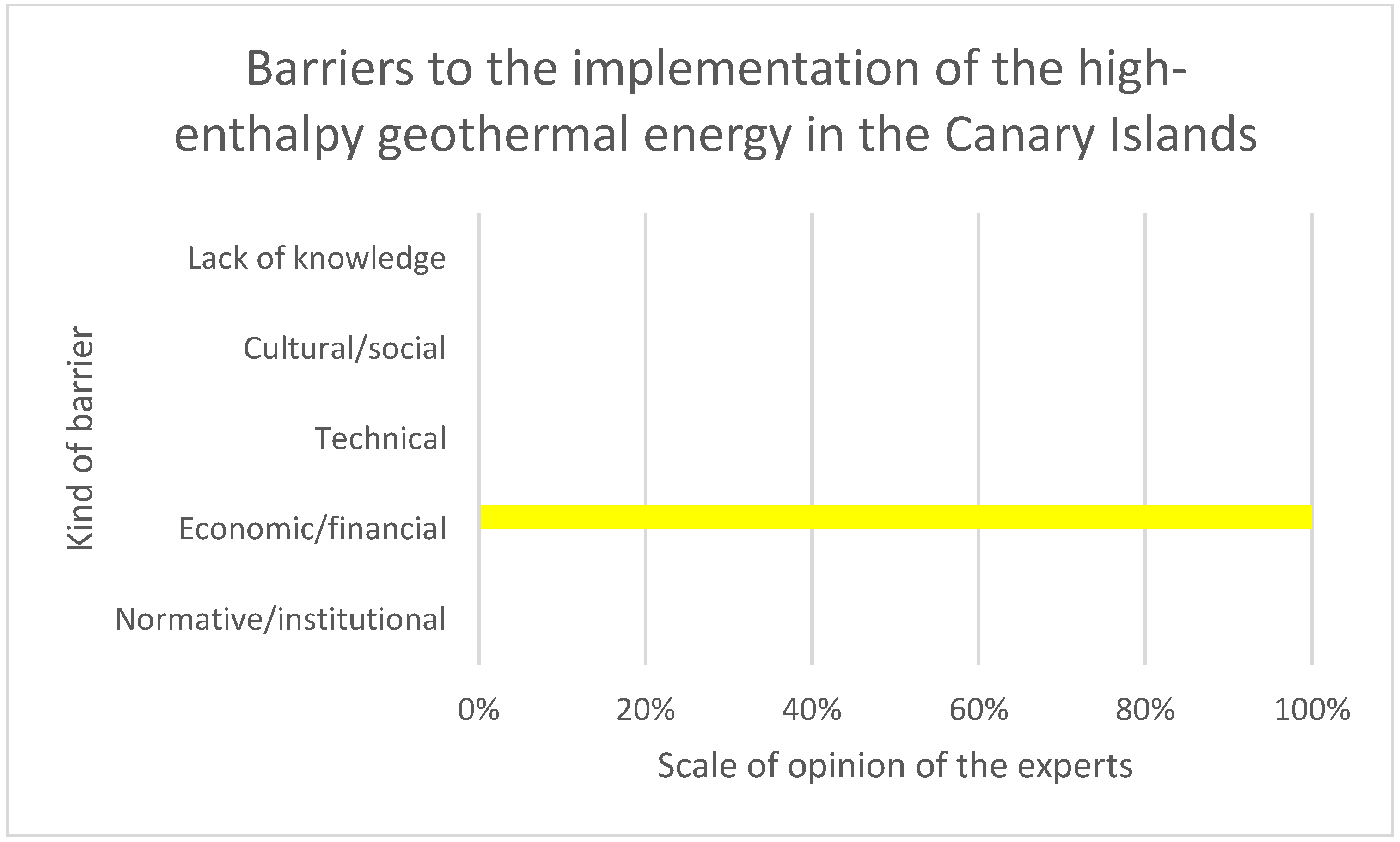
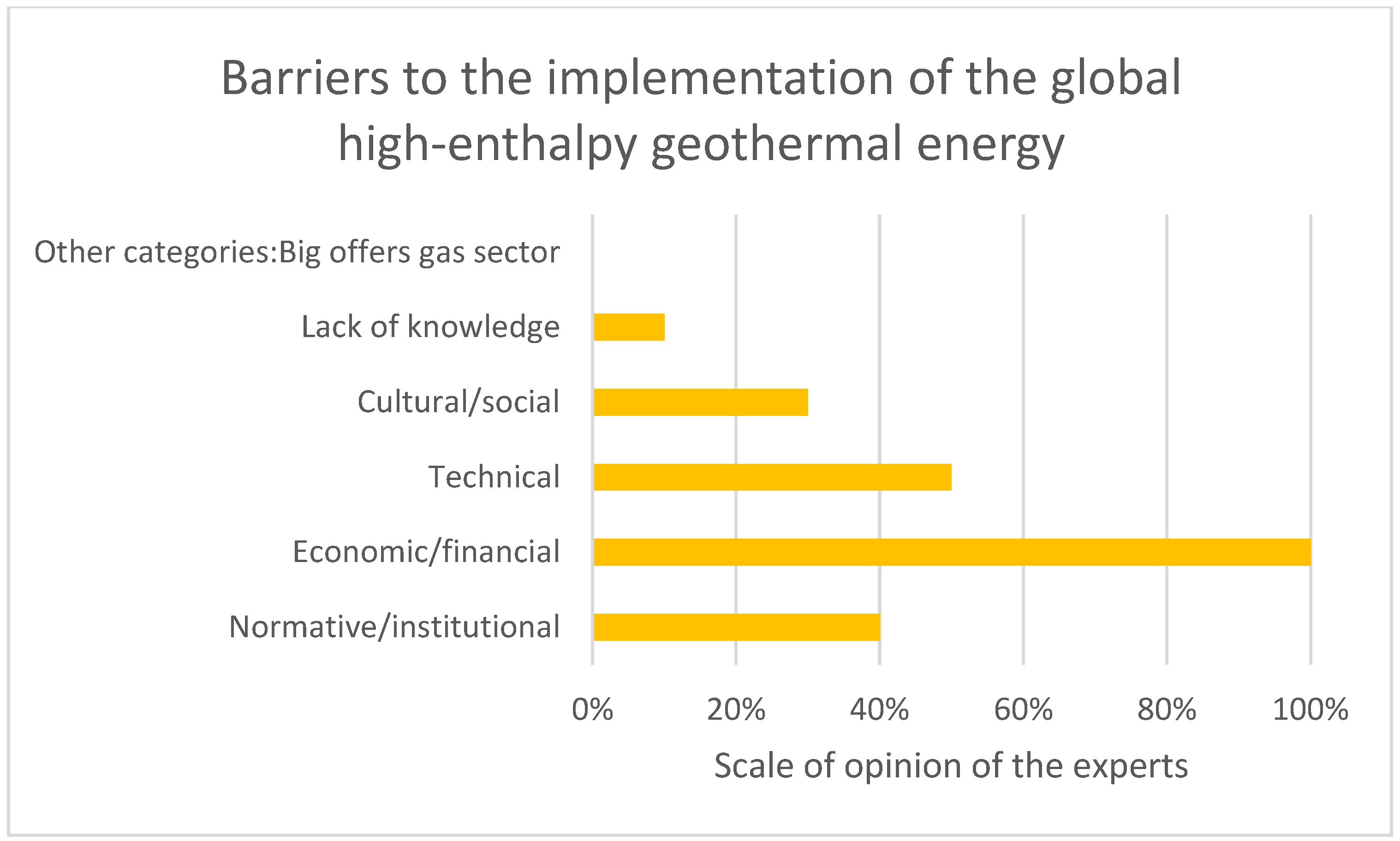
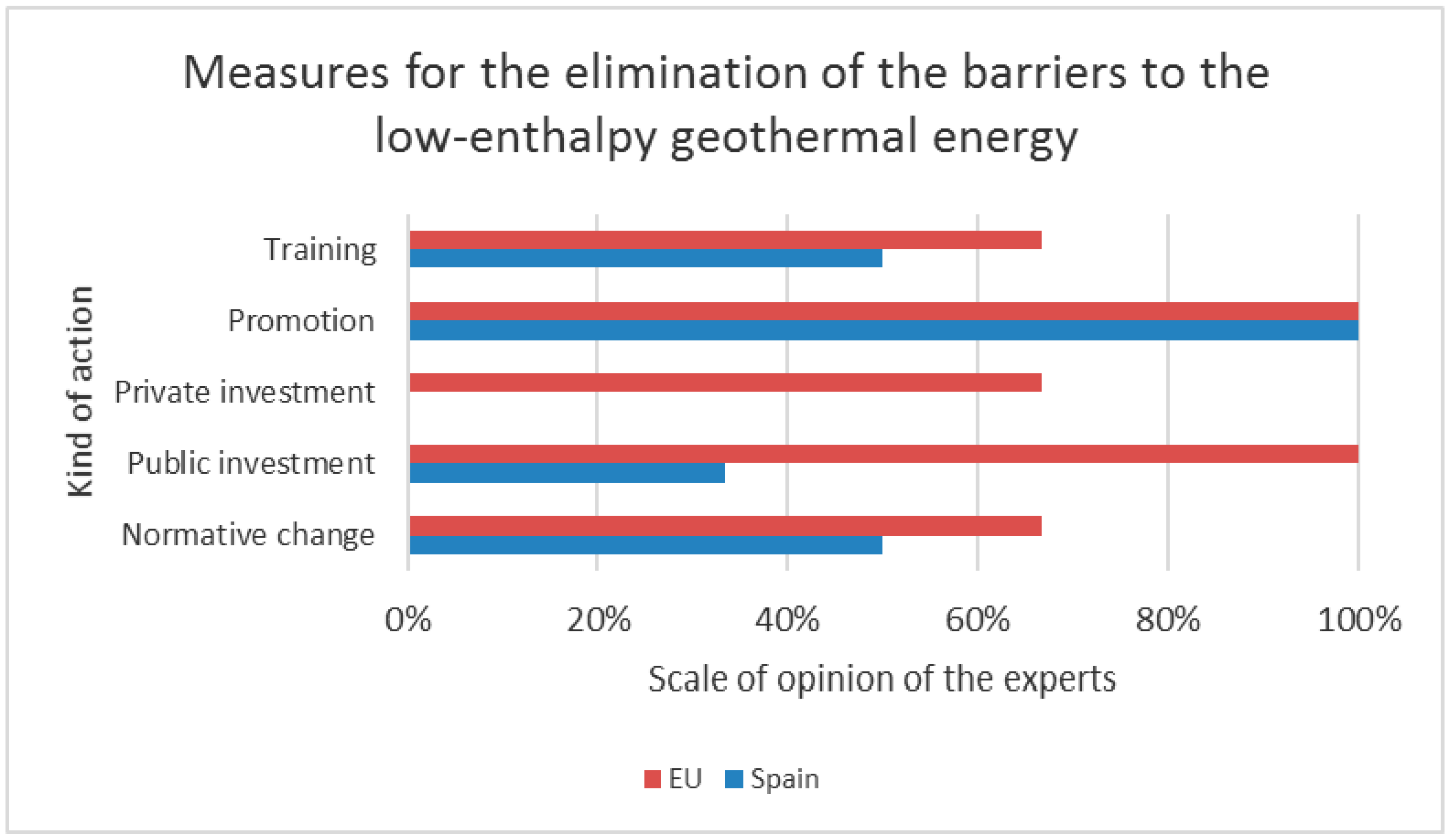
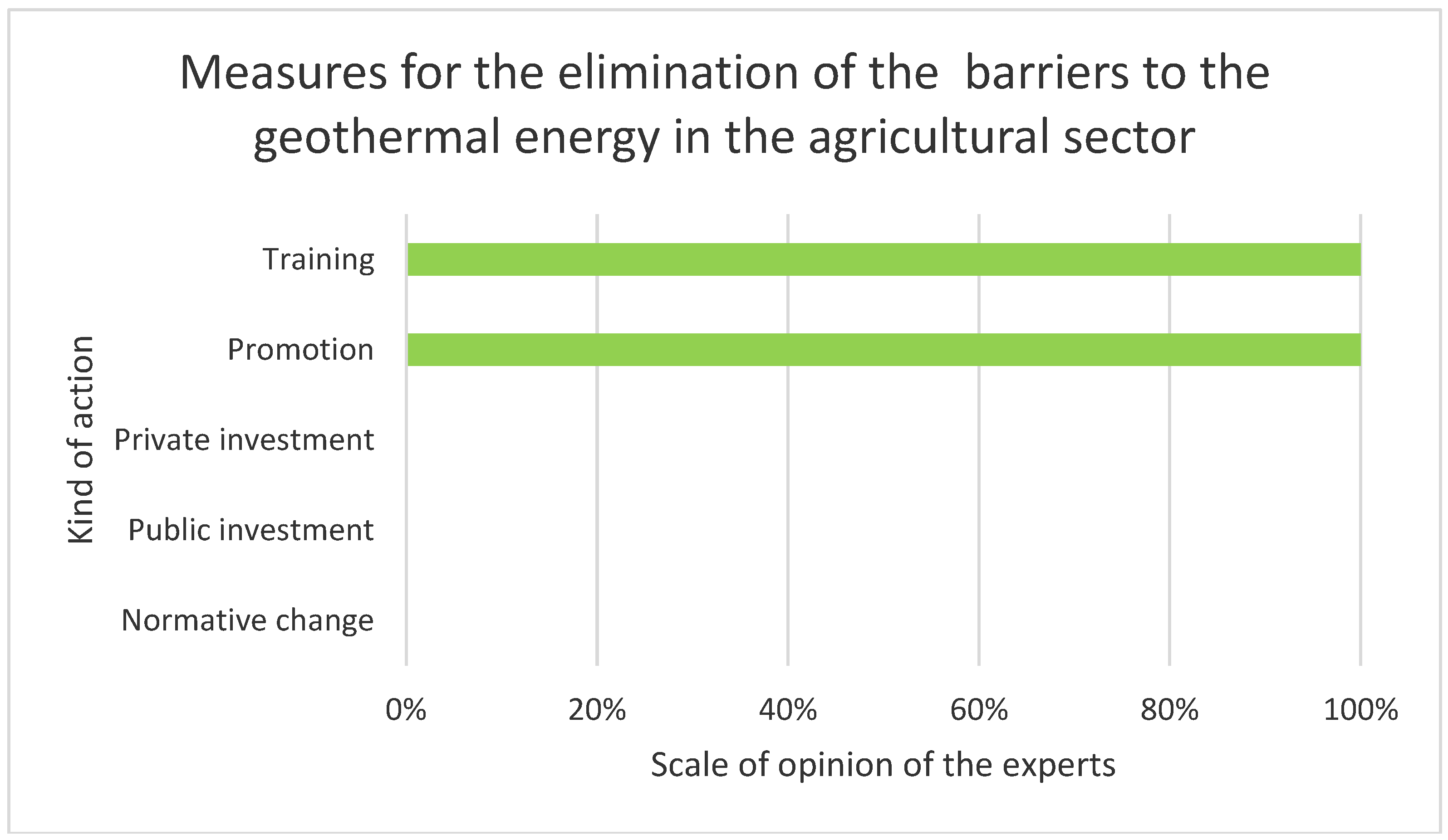
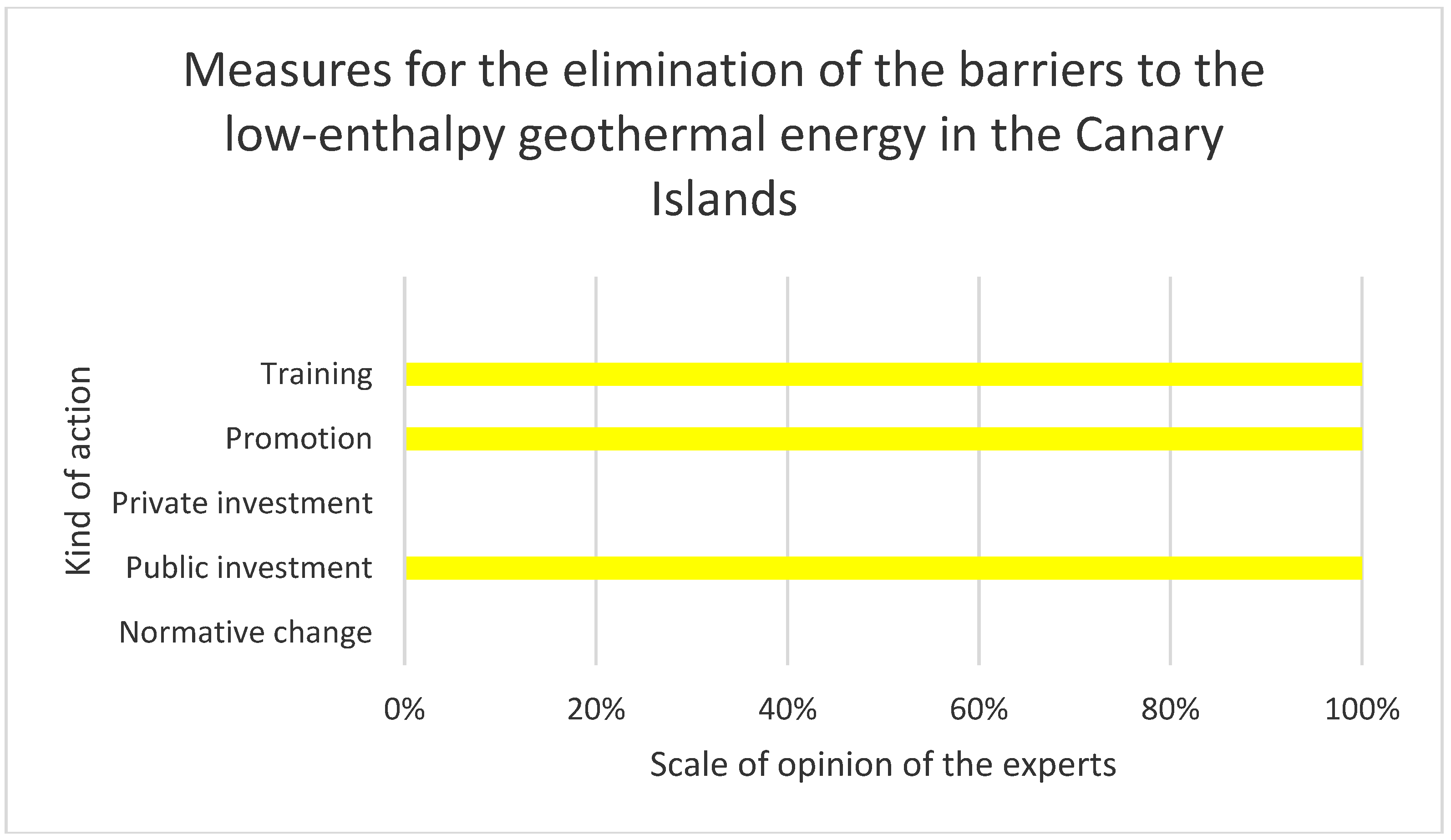
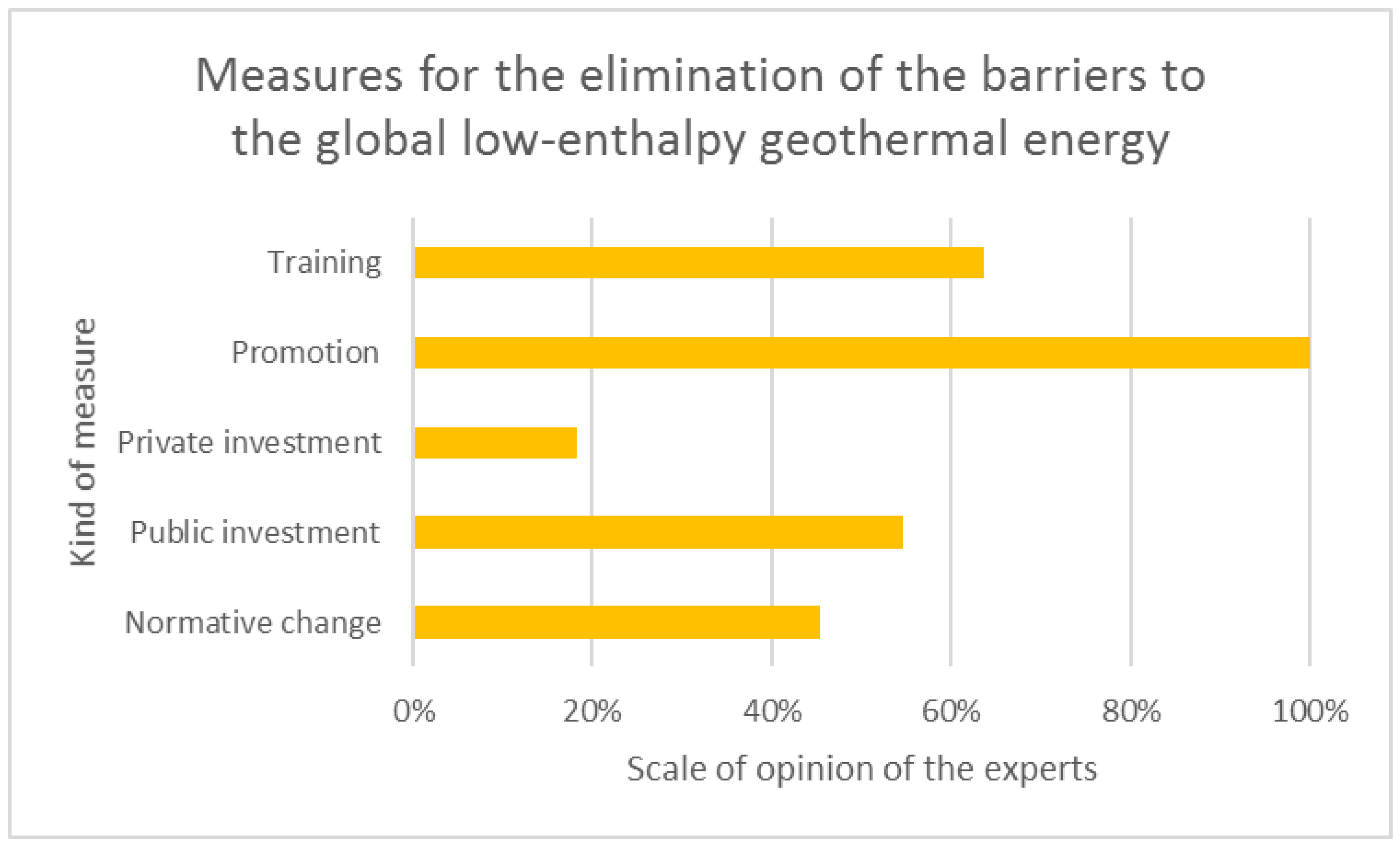
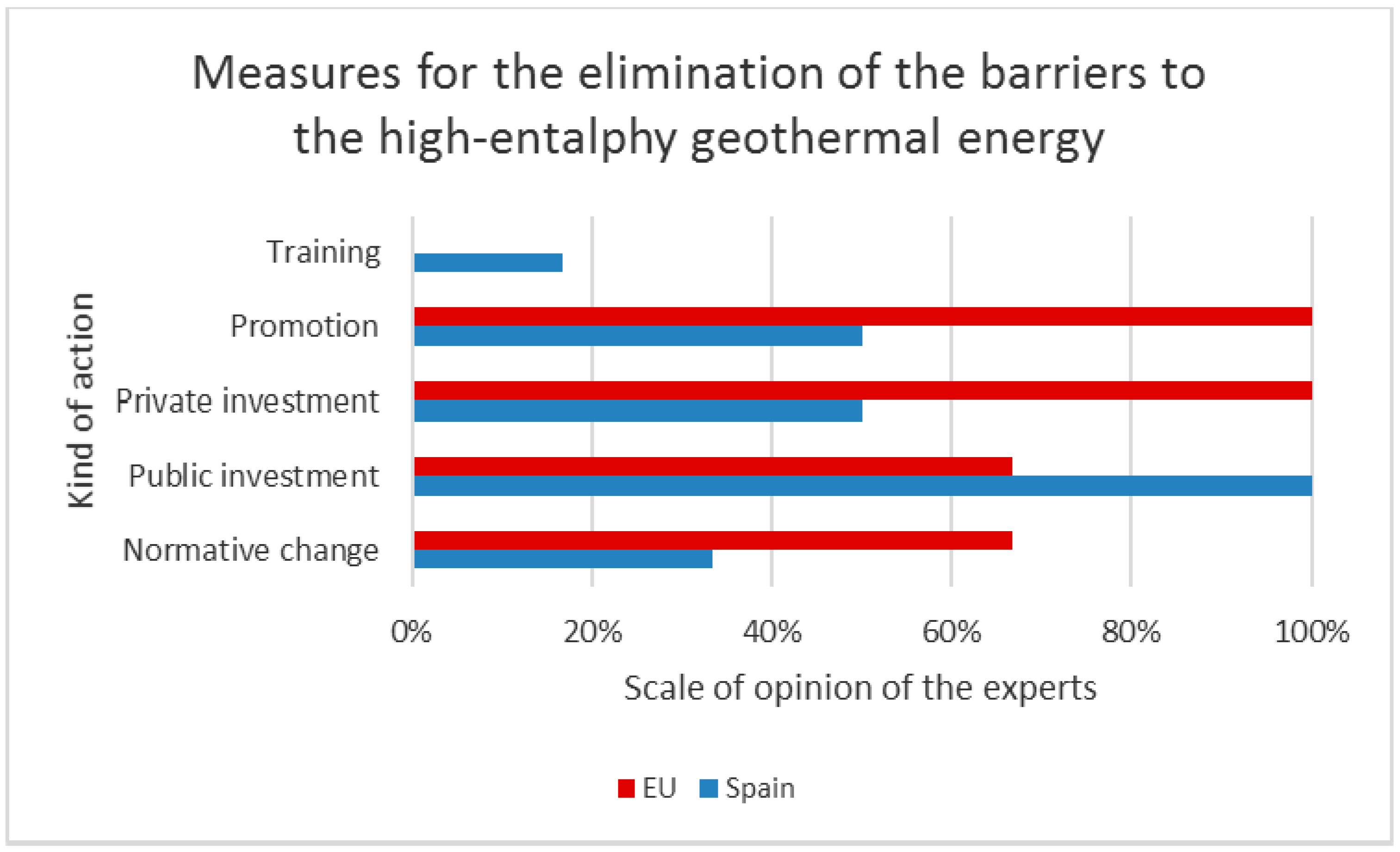
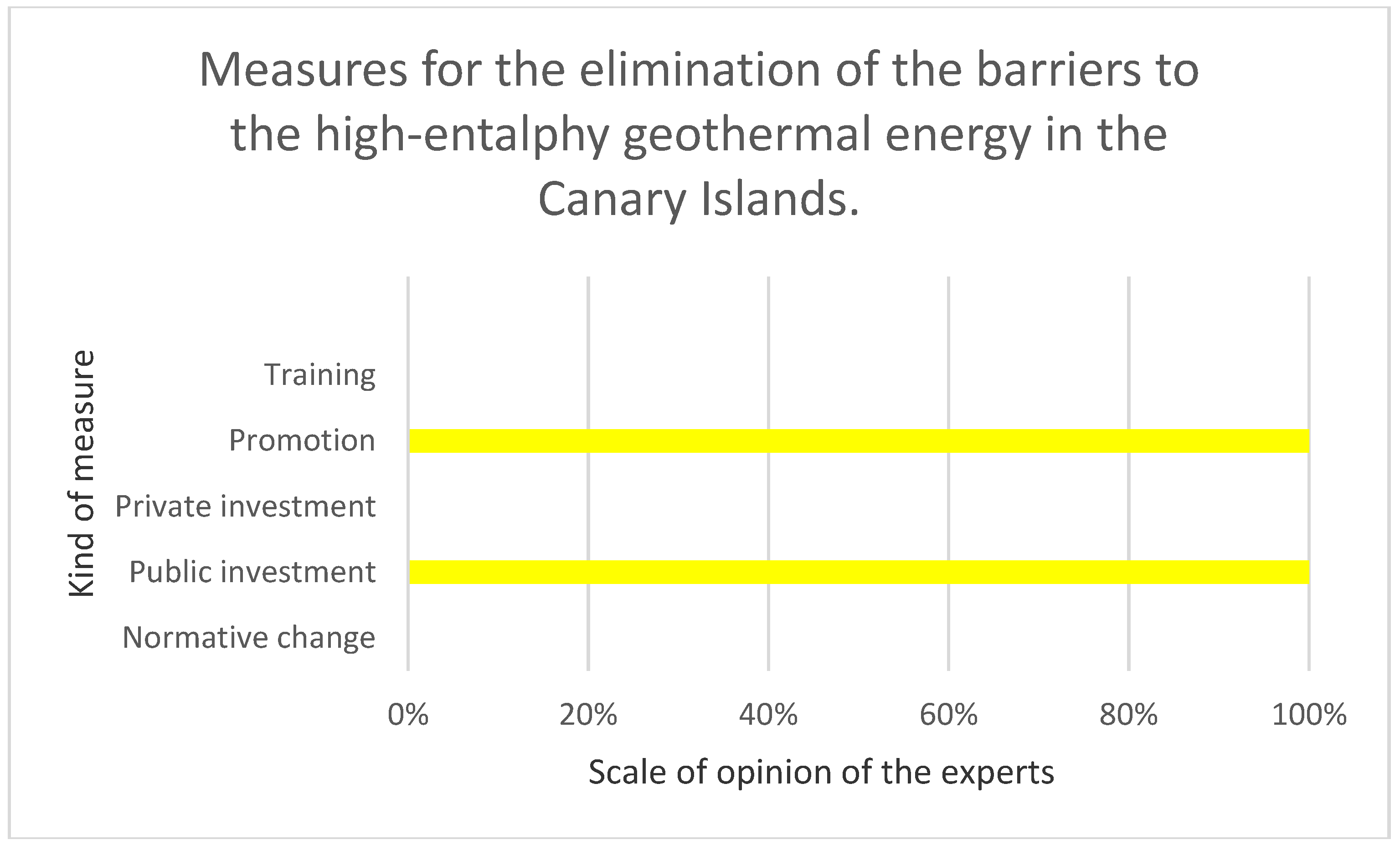
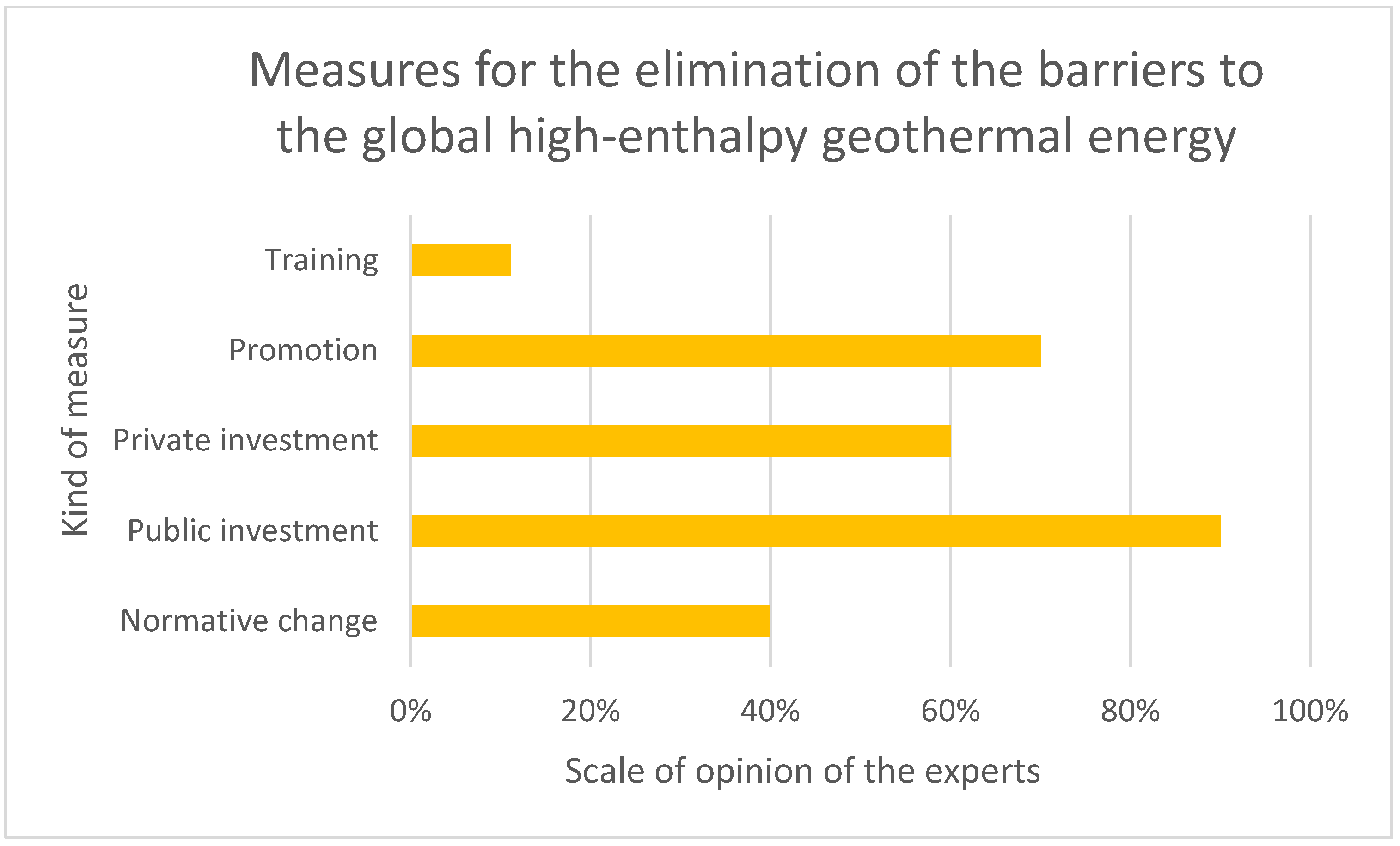
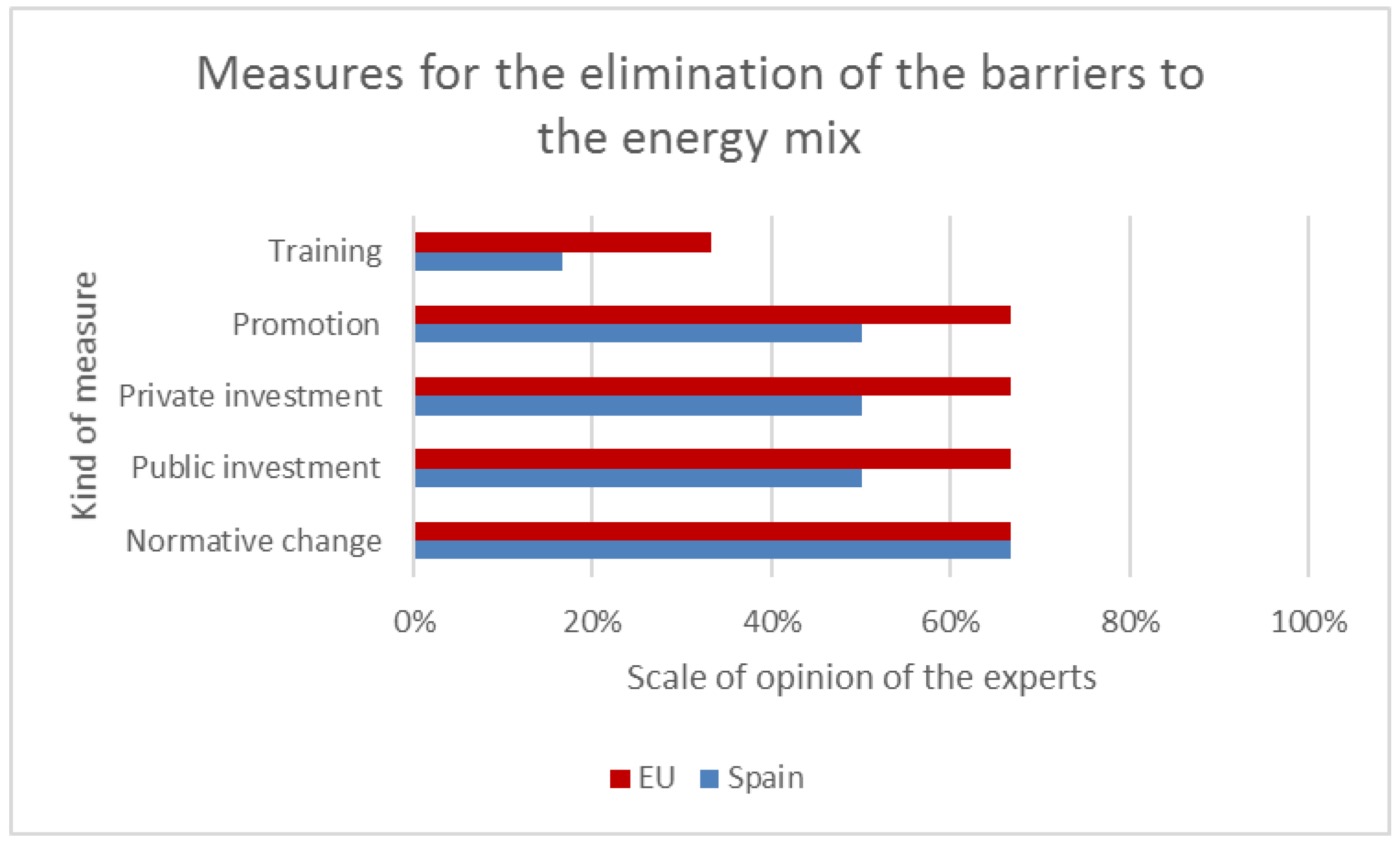
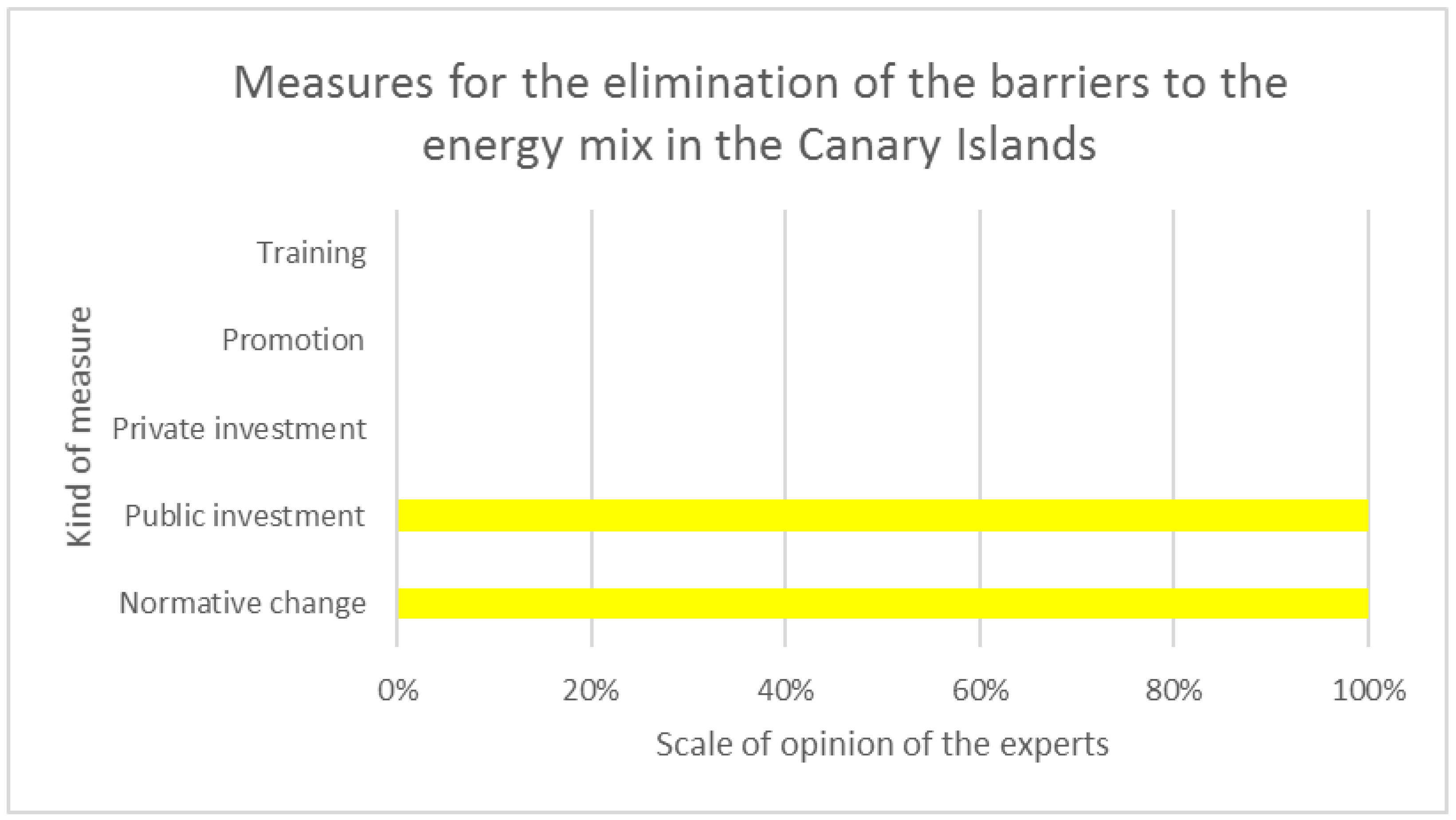
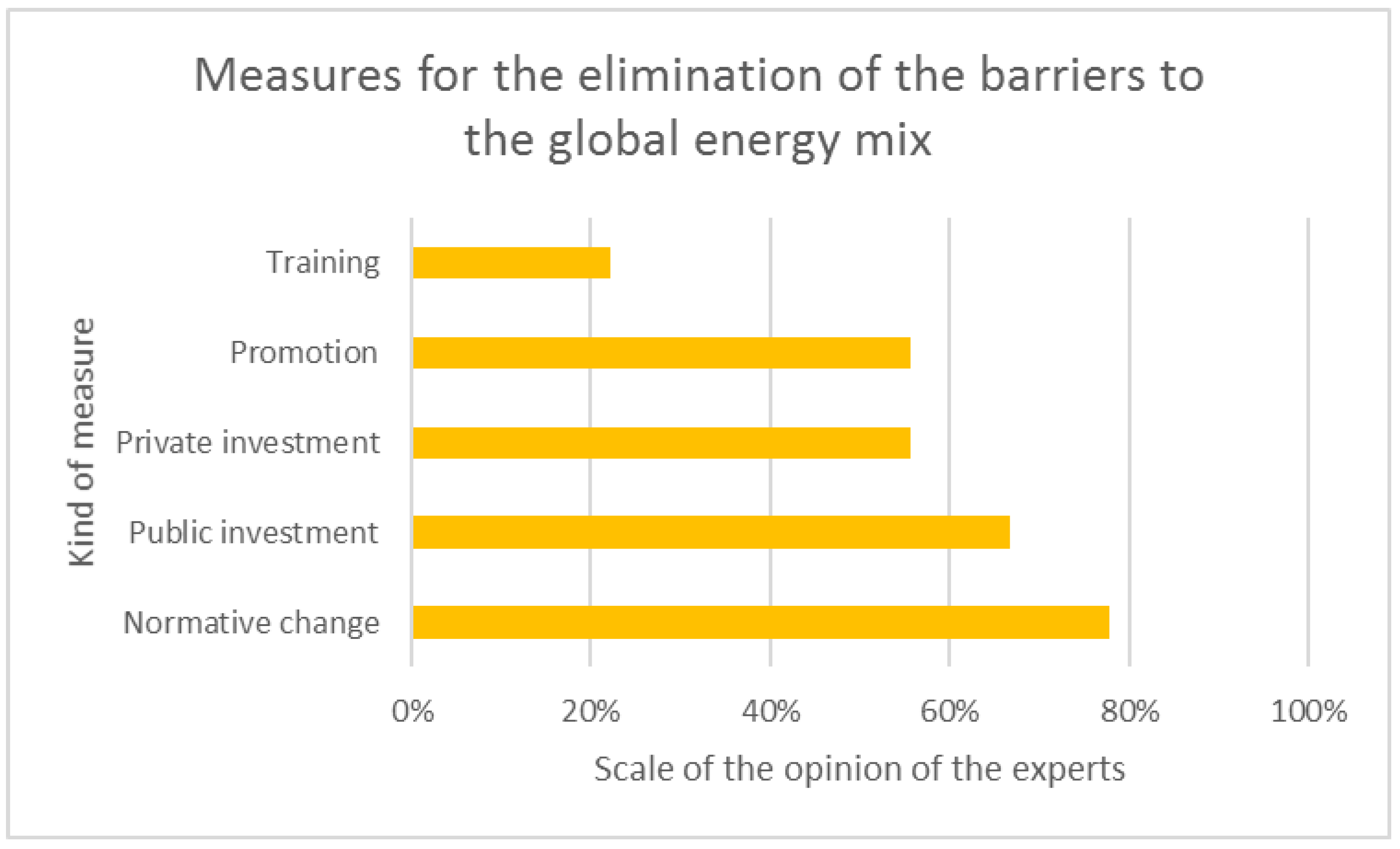
© 2018 by the authors. Licensee MDPI, Basel, Switzerland. This article is an open access article distributed under the terms and conditions of the Creative Commons Attribution (CC BY) license (http://creativecommons.org/licenses/by/4.0/).
Share and Cite
Colmenar-Santos, A.; Palomo-Torrejón, E.; Rosales-Asensio, E.; Borge-Diez, D. Measures to Remove Geothermal Energy Barriers in the European Union. Energies 2018, 11, 3202. https://doi.org/10.3390/en11113202
Colmenar-Santos A, Palomo-Torrejón E, Rosales-Asensio E, Borge-Diez D. Measures to Remove Geothermal Energy Barriers in the European Union. Energies. 2018; 11(11):3202. https://doi.org/10.3390/en11113202
Chicago/Turabian StyleColmenar-Santos, Antonio, Elisabet Palomo-Torrejón, Enrique Rosales-Asensio, and David Borge-Diez. 2018. "Measures to Remove Geothermal Energy Barriers in the European Union" Energies 11, no. 11: 3202. https://doi.org/10.3390/en11113202
APA StyleColmenar-Santos, A., Palomo-Torrejón, E., Rosales-Asensio, E., & Borge-Diez, D. (2018). Measures to Remove Geothermal Energy Barriers in the European Union. Energies, 11(11), 3202. https://doi.org/10.3390/en11113202







